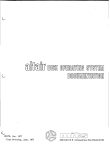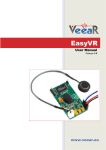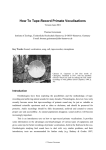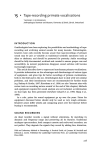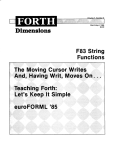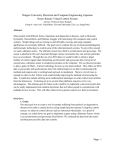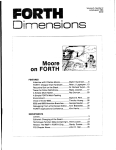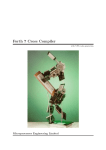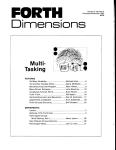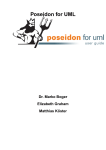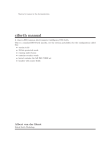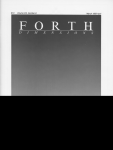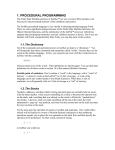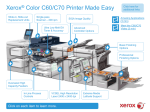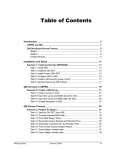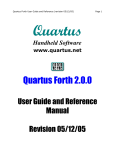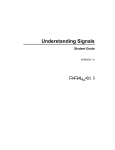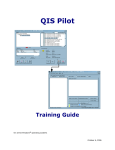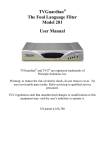Download 4 - Forth Interest Group
Transcript
What a year of transition! So much has transpired this past
year, I thought I'd take a few extra lines and share it with you.
/anuary-the FIG business and sales office moved from its
established home in Oakland, California to Carmel, California. Frank Hall retired as the Office Administrator after many
years of fine service to the FIG community.
February-200 boxes of back inventory was moved to
Monterey. We managed t o do this over a weekend. John and
Frank Hall, Skip Carter, and I moved each and every box. If
you need to fill in your library with back years of Forth Dimensions, you can do it through FIG. We even have a good
supply of FORML Conference proceedings. As we downsize,
this inventory will not always be available; if you want it,
now is a good time to get it.
March-the new FIG office started filling orders for books
and software, in addition to processing renewal memberships
and new memberships. The majority of our members come up
for renewal in March, so you can imagine the deluge of paperwork that came our way. Thankfully, at that time I still had
Julie Stone working in the office. Julie started with me in January to help get things organized. Her presence is greatly missed.
In March, the new FIG office successfully bulk mailed our
first issue of Forth Dimensions. We held our breath, hoping we
had done everything right that first time and that every FIG
member would get their issue as planned. In fact, Frank was
generous enough to come back for a day and help with the
bulk mailing procedures to see that we were on the right track.
April-more processing! More sorting! More archiving of
files! April was the month of trying to get our feet firmly
planted on the ground and to achieve a smoothly running
office. We went on-line with e-mail for the first time in our
new location! Now, not only were we processing orders and
renewals from mail-in responses, but the Internet was producing 10-20 e-mails a day! Believe me, for a first-time user
of e-mail, that alone can be intimidating.
May-I don't remember anything spectacular happening
in May, I think we just worked hard to get things caught up.
And, actually, I'm rather grateful for that.
/line-I decided to attend the Rochester Forth Conference
for the first time. It was great to meet more FIG members
and, as I've stated before, Larry and Brenda Forsley are wonderful hosts. The Forth community is truly fortunate to have
two great conferences here in the U.S. to attend.
ing to step u p and support FIG at a higher level. The advantage for the business is increased visibility o n t h e web site
and in Forth Dimensions. The advantage for FIG is a muchneeded increase in funds. Thank you t o all those first Corporate Members, you are the leading edge of a new level of support for the Forth Interest Group.
You'll notice in the last issue of Forth Dimensions, as well
as this issue, the listing of Benefactor Membership. John Hall
wanted to make known his willingness t o support FIG financially at the same level as the Corporate Members, but wanted
to do it as an individual: thus, the Benefactor level has been
established. Once again, a way t o donate t o FIG and get recognized for that donation. Please, if you're able t o do this,
contact me; we can convert an existing standard membership t o Benefactor status.
September- An exciting time! For the first time since January, we have increased our membership. Membership in the
Forth Interest Group had been o n a decline. With t h e addition of Corporate Memberships and the new Benefactor Membership level, FIG has new levels of financial support. With a
smaller membership and the continued support of higherlevel memberships, we can continue t o bring you t h e quality
product of Forth Dimensions, hopefully for years t o come.
October-time to prepare for FORML, a first for this office.
Each year, Bob Reiling undertakes the mammoth job of making the preparations for this conference held at the Asilomar
Conference Center in Pacific Grove, California. Have you attended? It's a fabulous place to meet the innovators of Forth.
You can meet and talk with Chuck Moore, Wil Baden, Elizabeth Rather, and Skip Carter, to name just a few.
November-it's FORML time. Not only did we get another
issue of FD out the door just a week before t h e conference,
everything managed t o go off without a hitch. Keep a n eye
o n the web site (www.forth.org) for new developments t o be
announced for next year's FORML conference.
December-time t o reflect o n this past year. Soon we'll be
adding a Volunteer Project List t o the web site. The Forth
Interest Group has more projects than we at t h e office can
possibly do alone. We need your help to increase our membership, be it in time or money; now is the time to volunteer
one or the other to FIG.
As always, we at the FIG office enjoy hearing from you, by
phone, by fax or by e-mail. This next year will prove pivotal
to the continuation of the Forth Interest Group-please be
part of it!
-Trace Carter
July-Back at the office, while I was still on the East coast,
Julie with the enlisted help of Brandon Yeager (many of you
know his name from e-mails; his time has been volunteered
as System Administrator of the FIG web site, in addition to
helping those of you who have trouble from time to time
getting o n the "Member's Only" section) successfully compiled and bulk mailed another issue of Forth Dimensions.
1
/
August-New levels of membership have been established! /
1 l3usin~sser
working with Forth and profiting from it are will- 1
2
Forth Dimensions XIX.4
Forth in Control: Analog/Digital Converters by Ken Merk
When controlling devices in the outside world using your parallel port, sometimes a need arises t o
monitor the device to see if it is responding properly. This feedback can be a digital signal that is fed
directly into the computer, or an analog signal that needs to be converted into digital form so it can
be understood by the computer. This article provides a tutorial approach to putting Forth in control,
and provides information about relevant hardware resources.
MicroFont: 4x5 by Rob Chapman
A fair number of embedded devices and other small systems incorporate a small liquid-crystal or
other display, such as the 128x64 one this author was using. Such displays may include fonts with a
limited character set or which are otherwise not optimal for the application. This article presents a
4x5 font that contains all printable ASCII characters, and is quite readable; and the Forth code can be
modified easily to extend or edit the provided characters.
Misty Beach Forth: An Implementation in Java by Mark Roulo
This article provides an overview of Misty Beach Forth, a Forth implementation running under Java.
While, at first glance, the two technologies would seem an easy fit, the Java Virtual Machine UVM)
has peculiarities that make the fit awkward. Further, in the spirit of Java's well-defined semantics, the
author added some design constraints that made implementing Misty Beach Forth harder than it
needed to be.
Factors Influencing the Use of Forth for Large Projects by Dr. Everett E Carter, Jr.
'She author looks at the factors involved in large projects and how these impact the choice of using
Forth for them. Frequently the choice of languages is dictated by managerial, customer, or agency
requirements that are really political and not technical decisions. For the most part, there is very little
one can do to deal with these kinds of directives on a project-by-project basis. In the longer view,
these decisions can be influenced by education and by ensuring that there are n o technical issues
regarding a particular language choice. Here we are primarily concerned with the technical issues that
become important when the system being created is large.
2
OFFICE NEWS
14
STRETCHING STANDARD FORTH
Formula Translation, using operator precedence
grammar
4
EDITORIAL
39
1
5
SPONSORS & BENEFACTORS
FORML'97 REPORT
Forth Dimensions XIX.4
3
Published by the
Forth lnterest Group
Marl~nOuverson
Every issue of this magazine reminds me of the generous nature of its many contributors.
I wish to voice a collective thanks to each of our authors, for whom the recognition of their
peers and the knowledge that they have made a tangible contribution are their primary compensation. And each reader supports this effort by keeping an active membership, for which
we remain grateful while striving to deliver at least an equal value in content each year.
Grass-roots participation has always powered this organization and, arguably, the Forth
language itself. The FORML Conference, the FIG Chapters, euroForth, the Rochester Forth
Conference, and the various electronic venues of Forth information and interchange all
thrive in the fertile fields of volunteer effort and enthusiastic participation. In my opinion,
the participation itself is a reward, beyond the knowledge shared and gained, the personal
and protessional contacts made, and the enhancing effect o n Forth careers and avocations.
I don't know who wrote the quotation shown on this page; it arrived via e-mail from an
unattributed source and has served as a salutary reminder.
I
It was great to be at FORML
nce again, this year. The re" V o f ~ n t e e are
r~ i
ort which begins o n the facreach beyond the
g Page
e conference's tone as well as
to contribute ti
content; those who are accusbelief that their activ
tamed to attending find it satisfying in many ways that I
to others as well a
hope others of you will be able
to discover
next year.
to themselves."
Keep the dates Open-yOu
be hearing
us in
I coming months, and from the way it is already taking shape, I suspect you will want to
serio~~sly
consider attending even if you have not before.
...
1
/
1
1
1
1
1
1
,
;
j
For this issue, Skip Carter takes a break from his Forthware column (so rest your math
muscles) to share the paper he presented at FORML. Those who have long wondered at the
relatively slight use of Forth for large software projects will find what is surely a compreliensive rationale and at least part of the remedy.
We are pleased to welcome Ken Merk back to our pages, with another in his occasional
series about controlling hardware with Forth. We know Forth is used in many embedded
and control situations-it has been claimed that, if one counts by the number of actual
devices manufactured instead of by co~nputerswith keyboards and disk drives, Forth might
be tlrc most-used software in the world. But it isn't always easy to learn how to achieve
llardivare control if one doesn't have a certain amount of experience. Ken's articles are a
I~cll-,to the hnrdware-challenged, and I am pleased to hint (but only a hint, for now) at
olher work in developlnent that will provide additional, expert help.
1,ooselyrelated to Richard Astle's remarks about implementing Forth, we find discussion
nbout a developing Java implementation. To date, most discussion in the Forth community
about Java has had the characteristic of drawing easy parallels; this author has more experience with Java than with Forth, and brings a different perspective as well as concrete approaches, goals, and con~parisons.It isn't as easy as those simple comparisons would have
it, but imagine downloading a Forth applet to any Java-enabled browser-not only to provide new functionality in the browser environment, but to offer practical demonstrations
of what we're talking about to a large audience that is, largely, willing to try "new" things.
We think this is an interesting project, with plenty of thorny performance issues to (try to)
~ c s o l \ ~let
c ; us know ivhat >,or1 think.
Circulation/Order Desk
Trace Carter
ForthDimensions welcomes editorial rnateria1,letters to the editor,and comments
from its readers. No responsibility is assumed for accuracy of submissions.
Subscription to Forth Dimensions is included with membership in the Forth InterestGroupat $45 per year(553 Canada1
Mexico, $60 overseas air). For rnernbership, change of address, and to submit
items for publication,the address is:
Interest Group
100 Dolores Street, suite 183
Carmel, California 93923
Administrative offices:
408- FORTH Fax: 408-373-2845
Copyright O 1997 by Forth lnterest
Group,l~c.Thematerial contained in this
periodical (but not the code) is copyrighted by the individual authors ofthe
articlesandby Forth InterestGroup,lnc.,
respectively.Any reproductionoruseof
this periodical as it is compiled or the
articles, except reproductions for noncommerciaIpurpose~withoutthewritten permission of Forth Interest Group,
Inc. is a violation of the Copyright Laws.
Any
bearing a copyright notice,
however,can be
onlywith permission of the copyright holder.
The Forth Interest Group
The ForthInterest Group is the associaand
tion of programmers,
engineers who create practical, Forthbaled solutions to real-world needs,
FIG provides a climate of intellectual
exchangeandbenefitsintendedtoas.
sist each of its members. Publications,
conferences, seminars, telecommunicationsand area chapter meetings are
among itsactivities.
FORTH DIMENSIONS (ISSN 0884-0822)
is published bimonthly for 545153160
Group at
per year by Forth
1340 M~~~~~ A
~ suite ~ 314, ~
Monterey CA 93940. Periodicals postage rates paid at Monterey CA and at
additional mailing offices.
POSTMASTER: Send address changes to
FORTH DIMENSIONS,100 Dolores Street,
Suite 183,Carmel CA 93923-8665.
--
Forth Dimensions XIX.4
~
I
I
I'm writing this in the time slip between the 19th FORML received with our registration packets. He was given an award
conference and the weekend it would have been by last year's
(he gets one most years) for "the most immediately applischedule. I would have been driving north now, on 5 towards cable nugget of code." Wil's other papers (he always brings
Los Angeles, full of Thanksgiving dinner, o n my way t o several) were o n Formula Translation, which has something
t o do with something called "Fortran," and "Semi-literate
Monterey, Pacific Grove, and Asilomar by the sea.
The switch from Thanksgiving weekend to the weekend
Programming," which describes his method (an excursion into
before had its effects, besides giving repeating conference at- territory previously colonized by Glen Haydon) of mixing
tendees a sense of dislocation: lines for lunch and dinner were code and comments in a single text file so it can be compiled
shorter, and parking was easy in Carmel. The change may and printed several different ways for different purposes.-~his
have kept some from coming (costing a vacation day) but it last paper provoked Dr. Ting t o remark that Wil has too many
also meant the presence of some who have other things to ideas for the rest of us conveniently t o absorb. Wil's eventual
response to that remark was that if h e sees a fat rabbit crossdo on holidays. Forth, Inc.'s Elizabeth Rather, the "second
Forth programmer," attended for the first time, though some ing the road he's going to chase it.
If you get the idea that the conference was largely a group
of us were surprised when she said so, having seen at least
of old friends sitting around talking, or standing up in front of
her ghost there previously.
Asilomar and FIG are both under new management this each other and talking, that would describe about half of it.
Another award came out of that first afternoon session
year, and though FIG is none the worse for it, the same cannot quite be said of Asilomar, though noticeable ill effects for, if my notes are correct, "Just a ROM to run the dog." It
were small: new rules mean box lunches have to be ordered was Dr. Ting's turn t o bring a robot this year, and he brought
"Gogo: a Mindless Robot." Unlike Skip Carter's six-legged
two days in advance, and bartenders must be hired to moniwalker (featured in Dr. Dobb's after last year's conference), Dr.
tor corkage fees at our traditional evening wine-and-cheese
parties. FORML has a life of its own, however, and a continu- Ting's rolled, controlled by bumper sensors a n d a statemachine, but it was strong, powered by a car battery and wiper
ity provided by Bob Reiling's directorship which allows that
life. Bob opened the conference with reminiscences, and motors and, though it threw a wheel, it didn't break a leg.
Between t h e first two sessions, Friday afternoon, we
-showed photos from former years, including one of a bushy
Marlin Ouverson with, I'm convinced, a clean-shaven me in checked into our rooms and, though mine was o n the second floor, with n o deck and an interior hallway, I saw a deer
the background.
wander through the trees below my window.
FORML kept its usual schedule: papers presented in two
The second afternoon session had three papers: one of
afternoon and one evening session o n Friday and two morning sessions on Saturday, working groups Saturday afternoon, Wil's, a typically apt Forth philosophy talk by Glen Haydon,
impromptu talks Friday evening, closing remarks, awards and another prize winner (for "outstanding contribution to
(bottles of wine for categories invented at the last minute) the future of Forth"): Skip Carter's "Limits t o Growth." Skip's
and a panel discussion Sunday morning, group meals all days, main point was that a language's available toolset, more than
and wine-and-cheese parties (accompanied by various hard- its syntactic or semantic power, determines what it is likely
and software demonstrations) both evenings. In the gaps, we to be used for. So, according to Skip, assembly language is
walked the boardwalk and the beach, watched waves and deer used for small embedded systems projects, Forth for mid-sized
Elizabeth Rather quesand snakes, and generally enjoyed ourselves.
projects, and C/C++ for large
Sessions [and parties) were held this year in Heather, a tioned whether this were a "political rather than a technical"
meeting room in the basement of one of the newer buildings issue but continued the theme in the evening session when
in the center of the Asilomar grounds, where we last met about she announced Forth, Inc.'s forthcoming "SwiftForth," a
Windows-hosted Forth system and environment, with subfourteen years ago, my first FORML. There were passions then,
routine-threaded code, in-line substitution, dialogs, and
talk about Neon, which left Forth to become Actor, mention
of that great almost successful Forth project Valdocs, Leo menus. Not only does this Forth promise, according to benchmarks, to compile faster code, in most cases, than polyForth,
Brodie, not enough chairs, a sense of excitement. The Forth
community has matured, or aged, sobered up a little (even MPE, and Win32Forth, it will also provide at least some of
the late night sessions are tamer), and shrunk (if conference the development tools taken for granted by C++, Delphi, and
attendance is an indication). There were two dozen of us this. even Visual Basic programmers. Although it won n o wine
award, this announcement seemed t o provoke the most inyear, mostly familiar faces, mostly Californians.
Sessions were chaired, efficiently and more gently than terest. In the final conference session many of us expressed a
would have been possible in the past, by Guy Kelly. There desire to investigate (i.e., "play with") SwiftForth, at least if
were more pre-submitted papers than last year (there could the price is right, and only one expressed a refusal t o "conhardly have been fewer), and at the first session we started tribute to the dark side."
The Forth world has a number of icons, names, figures
going right through them. One of t h e most interesting
papers was the first, Wil Baden's discussion of an implemen- everybody knows or knows about: Laxen and Perry, who wrote
tation of an encryption scheme he calls "Arcipher," also dis- F83; Tom Zimmer, t h e principle architect of F-PC a n d
cussed in his column in the issue of Forth Dimensions we Win32Forth; Bill Ragsdale, from the early days; Chuck Moore,
Forth Dimensions XIX.4
5
of course, who gave us all of this like Little Richard gave us
rock-and-roll; and Elizabeth Rather's Forth, Inc., the main
bastion of professionalism in a field often characterized as
amateurish and maverick. Everybody knows that Forth's greatest strength, its ease of implementation, is also its greatest
weakness ("if you've seen one Forth, you've seen one Forth"),
leading to mutual incompatibility and an inability to support compiler vendors. However much C/C++ programmers
might complain about Microsoft's and Borland's compilers,
the fact that they have to wait for the next release for bug
fixes keeps them united. Perhaps, with Windows and other
complications, the computing world, for better or worse, has
finally gotten to the point that a Forth vendor can make
money selling systems to the rest of us, in which case we'll be
glad Forth, Inc. has survived this long. I know I'll buy
SwiftForth, if I can afford it.
Other papers in the Friday evening session included Dr.
'ring's on the PowerPC as a Forth engine, Guy Grotke's "Subversive Forth," on using Forth to write tools in a non-Forth
shop for a team that otherwise had to wait for a "tools group"
to develop them, and my contribution, a paper about a subroutine-threaded Forth with in-line macro substitution for
the shnoom chip, originally designed by Chuck Moore and
now the property of Patriot Scientific in San Diego. The history of shBoom, both legal and technical, is murky, but it's
still Chuck's in spirit, a g e n u i n e Forth processor k i t h two
stacks and byte-sized machine instructions which manipulate them. Patriot is putting Java on it; I've put Forth there (it
was easy-I should have won a "coals to Newcastle" award).
After the evening papers we drank wine, ate cheese, saw
SwiftForth and the shBoom chip, and kicked around Dr. Ting's
robot. The presence of an Asilomar employee as bartender
had little dampening effect, and we scurried to an upper room
afterwards as usual, though I understand that session broke
up long before dawn.
One year ago, at this time, the morning after Thanksgiving, 1 was driving north through Big Sur, stopping for coffee
at Nepenthe, thinking about what was about to happen. This
year 1 already know.
The first Saturday morning session had perhaps the two
best paper titles of the conference: Charles Shattuck and Bob
Nash's "Chucking Forth," and Peter Midnight's "How I got
caught in a tree by two Russians but eventually found a ladder." Nash, a good storyteller, described a project for which
he and Shattuck wrote assembly language in a Forth-like way,
with named macros but without a dictionary or a parameter
stack, and left Shattuck a few minutes for technical details at
the end. Peter Midnight's talk defies description, traveling
through AVL-trees, serial programmers, and algorithmic er-.
rors to explain his title, which deserved, but did not get, a
bottle of wine.
'She second Saturday session had two presenters. Rob
Chapman, a Canadian who's never cold in Northern California, talked about neural nets; and Elizabeth Rather talked
about Forth, Inc.'s "Next Generation Forth Cross-Compilers"
and their project, "Open 'Terminal Architecture for Europay
International," perhaps the biggest Forth project currently in
developn~ent.
Papers were over by Saturday lunch. The afternoon session, traditionally fragmented into working groups, departed
from tradition to be, for the most part, a working group of
the whole, stepping through the list of discussion topics to-
gether. It was all largely civil, n o heated discussions of blocks
vs. files, so that someone complained "There's n o fire in this
group anymore." We discussed the requirements of a modern Forth environment, bowing towards t h e reality that, to
be used widely, it has to be Windows hosted, and has t o make
use of modern tools like version control. There were some
relatively abstract discussions of reconfigurable hardware and
Forth architecture, and concrete discussions of motion control and team software development. This last topic was particularly interesting, since the image of a Forth programmer
is of a lone horse heading for the barn, but most of the people
in the group claimed to have worked o n Forth teams of more
than three programmers. The lone horse tendency was alive,
though, in resistance to code reviews,. as though professionals have nothing to learn from, or teach to, each other.
The Saturday evening impromptu talks are always a highlight, ranging from the silly t o the serious. Often, the most
useful bits come out of these talks, half-formed or apparently
small ideas not ready for or deemed worthy of a full conference paper. It's also the time we get t o hear from Wil Baden's
alter egos (B.W. Daniels this year), and to hear what Chuck
Moore has been doing in his spare time ("color Forth"). Someone said my presentation of Wil Baden's portable implementation of my word RETRY provoked some heat, but I didn't
feel it. And one prize-winner came out of these talks: Kevin
Bennet, I think the youngest attendee, got a bottle of wine
for "The Most Outstanding Real-World Result" for a discussion of using Forth to control kilns in a paintbrush handle
plant in Oregon.
At the wine-and-cheese party, Dr. Ting played excerpts
from a CD of a performance of Eternal Sorrow, a Chinese poem
by Po Chu-i which Dr. Ting set t o music by Franz Schubert.
Most of us sat rapt. Dr. Ting was not the singer o n the CD,
but he did entertain a few of us later with a Chinese tonguetwister about hunting stone-lions with a bow-and-arrow,
which involved a lot of hissing. That night there may have
been n o after-party session: at least, many of us regulars went
to bed early.
A year ago, at this time o n this day, I was checking in to
FORML, getting my notebook and nametag and Wil Baden's
opening bear hug.
The Sunday morning session is for closing remarks, awards,
thanks all around, a panel discussion, and plans for next year.
Bob Reiling thanked Guy Kelly for chairing this year's session; Dr. Ting talked about his Win32Forth manual; Chuck
talked about iTV; John Hart had a few things to say about a
minimal Forth engine; Trace Carter talked about the state of
FIG, which is getting healthier but still needs about twice as
many members to be viable. After a break the final session
was run by Guy Grotke, who made the panel discussion a
round-robin, which got a little heated (someone said FORML
this year was "pathetic," since there were so few papers, so
little heat, so little prepared in advance), but gave us all a
chance to mention the place of Forth in our lives.
The final note was Bob Reiling's discussion of plans for
next year-same time, same place. It will be the twentieth
FORML conference, a kind of milestone, and will fittingly
be chaired by our noble editor, Marlin Ouverson. Remarkably, Dr. Ting got some to commit t o titles for papers for
next year. There will be brass bands and lion tamers. So you
better all come.
After lunch we all went home, Thanksgiving still ahead.
Forth Dimensions XIX.4
I
When controlling devices in the outside world using your I
parallel port, sometimes a need arises to monitor the device
to see if it is responding properly. This feedback can be a digital signal that is fed directly into the computer, or an analog
signal that needs to be converted into digital form so it can
be understood by the computer.
An analog-to-digital converter is a device that senses a
voltage difference between two input pins and converts it
into an equivalent binary code at its output pins. When the
Vin+ is equal to Vin- the converter will output a 00. When
the Vin+ input analog voltage is equal to the sum of Vref and
Vin-, the converter will produce the full scale code FF. The
eight-bit converter we will be using (ADC0831) can convert
an analog voltage of 0-5 volts into an eight-bit binary number between zero and 255.
The process of measuring an analog signal and then converting it into a binary number is called sampling. Each digital sample represents the amplitude of the signal at a specific
time. The rate at which the binary number is updated is called
the samnplirzg rate, and the speed at which the converter can
turn the analog input into a digital output is called the conversiorz time (32 microseconds for the ADC0831).
Analog signals are infinitely variable in amplitude, but the
smallest step in which the digital output can vary is 19.53
mv; thus, the AID converter cannot perfectly represent the
amplitude of an analog signal. With Vref at 5.0 volts, the resolution of each step will be 51256 = 19.53 mv for an eight-bit
AID converter.
The number of bits in an AID converter determines the
resolution of the converter. An eight-bit converter will discriminate to one part in 256, which is a precision of 0.4'H). A
ten-bit device gives a precision of better than 0.1(%),and a 12bit device a precision of 0.024'%).For most general applications, eight-bit precision is sufficient.
In this article we will connect the ADC0831 to our parallel port and control it using Forth.
The ADC0831 has been around for a while and is an industry workhorse, which makes it easy to obtain and quite
inexpensive. The digital output is serial, which cuts down o n
the number of pins o n the chip (eight) and simplifies the
interface to the parallel port.
Pin #1 of the chip is the chip select. Placing a logic low '
enables the AID operation.
Pin #2 accepts the input signal Vin+ (0-5 volts).
Pin #3 is set to the zero-reference voltage (Vin-) which
determines what value of Vin+ will produce a zero output
reading.
Power (5 volts) is applied to pin #8 (Vcc) and Gnd to pin
#4. Serial conversion data is sent out pin #6 with the mostsignificant bit first. The output data is synchronized with clock
input on Pin #7.
Forth Dimensions XIX.4
The voltage applied to Vref Pin #5 determines what value
of Vin+ will produce a full scale output reading of FF. The sum
of Vin- and Vref must be 5 5 volts. For our circuit, Vin- (pin #3)
will be 0 volts (Gnd) and Vref (pin #5) will be 5 volts (Vcc).
You can download a copy of t h e data sheet for t h e
ADC0831 from National Semiconductor's Web site (http:/1
www.nsc.com). Do a search by part number.
The AID circuit is quite simple. A voltage regulator feeds a
steady 5 volts to power the ADC0831 chip. The parallel port
controls the chip directly through pins 1 and 7. A 10K potentiometer (pot) will simulate our sensor, which will produce a
variable 0-5 volts into the chip. Build u p the circuit as per
schematic [page nine]. A 9 volt battery or an AC power adapter
can be used for the power supply.
Plug the DB25 connector into your parallel printer port and
power up the board. Run F-PC and, at the "ok" prompt, type
FLOAD ADCO 8 3 1 . SEQ. If n o errors are encountered, type
SHOW. DATA to run the program. A simple display will appear,
which will show the conversion value (0-255) and the calculated voltage (0-5 volts). With a small screwdriver, turn the
pot (simulated sensor) t o both extremes and watch the display
change accordingly. To prove that the circuit is working, measure the input voltage with a voltmeter and verify this value
with the displayed value. Hit any key t o exit the program.
Source Code
ADC0831.SEQ automatically searches for an active LTPl
port and assigns the port address t o the constant # P O R T . If no
active port is found, the error message "Parallel printer port
not found" will be displayed.
The heart of the program is the word CONVERSION. It clears
the value A D r e s u l t which will soon contain the conversion
value read from the AID chip. The chip is enabled and a
dummy start pulse is sent t o bring the Dout line out of its
high-impedance state. The next clock pulse enables the mostsignificant bit to appear, which is read by out?. This continues for a total of eight bits, which are shifted left into the
value A D r e s u l t . The chip is then disabled.
The word SHOW. DATA takes t h e value from A D r e s u l t and
prints it to the screen, along with t h e calculated voltage.
This whole procedure is repeated until a key is pressed.
Sensors
Here is a brief list of other sensors you can implement
with this circuit.
1
Direction Sensor
The pot we used to simulate a sensor could be made into a
real sensor. Its circular motion could be used t o measure direction in degrees. A single-turn pot could measure angles from
0-360 degrees. (Single turn pot, ETI Systems Model SP22E.)
7
I
1
p in ear motion
sensor
A linear motion potentiometer is electrically identical to
our circular motion pot. It is a three-terminal device that
moves in and out to measure linear distances. Strokes from
112 inch to four inches are available. The output would be 05 volts, fully retracted to fully extended. The shaft can be
attached to -any moving part to give positional feedback to
the computer. Spring return shafts are also available. (Linear
motion pot, ETI Systems Series LW12.)
1 lightA simple
Sensor
I
photo-cell in series with a resistor to form a voltage divider circuit is all that is needed t o measure light intensity. If the junction point of the two devices is fed into the
ADC0831, a varying voltage will be present that varies with
the light intensity. Applications such as intrusion alarms,
event -counting on production lines, or automatic dusk-todawn lighting are possible.
Pressure Transducers
Data Instruments makes a whole line of pressure transducers, three-terminal active devices that will output a voltage proportional to the input air pressure. heir-~odel SA
series is encased in a steel housing and can measure up to
5000 psi. (Information available at
Acceleration/Deceleration Sensor
Acceleration is the change in velocity with respect to time,
and is specified in feet per-second squared. sometimes it is
referred to in terms of gs. One g is equal to the acceleration
caused by earth's gravitational field, or 32 feet per second
squared.
The ADXLSO accelerometer chip by Analog Devices will
generate a voltage output proportional to any changes in velocity affecting it. The device sensitivity is factory trimmed
to 19 mv/g, resulting in a full-scale output swing of f0.95
volts for a-+50g applied acceleration. ltszero-g level is +1.8
volts. Together with its internal amplifier and a resistor network, the sensitivity of the chip can be changed. When
1 changed to +20g sensitivity, the zero-g output voltage is 2.5
volts, which will vary by 0.1 volt per g of acceleration. When
1 subjected to the maximum value of f20g, the output will
swing k2.0 volts f r o ~ nits zero-g level of 2.5 volts.
'This chip is currently used in air bag deployment by the
automobile industry. A more sensitive version of the ADXLSO
is also available. he ADXLOS can detect up to f 5 g, making
it useful for vibration detection. (ADLXSO f 5 0 g range,
ADLXOS f 5 g range. Analog Devices data sheets available at
http://www.analog.com.)
Magnetic Field Sensor
A magneto-resistive sensor made by Philips can be used to
measure magnetic flux density. The sensor consists of four
Hall-effect devices arranged in a bridge configuration. When
it is placed in a magnetic field, a voltage is provided across it
which varies linearly with the magnetic flux density. A current-carrying conductor (wire) is surrounded by a magnetic
field whose strength is proportional to the value of the current. This sensor can be used to measure current flow simply
by placing it in close proximity to the conductor. current
values could be monitored or it could be used simply to supply feedback that the device is operating. (Magneto-resistive
sensor, Philips Type KMZlOB. Data sheet available at http://
www.semiconductors.philips.com.)
1
/
1
Going Further
Another useful feature of the ADC0831 is that it can operate ratiometrically. Here is an example of how this works.
Let's say you have a sensor that has a span, or dynamic
voltage output range, of 0.5-3.5 volts instead of 0-5 volts.
Our results would not contain the full eight-bit resolution,
because of the limited voltage span (three volts). We can feed
0.5 volts to Vin- to absorb the offset, and set Vref to 3.5 volts.
The ADC0831 will now encode the Vin+ signal from 0.5-3.5
volts with the 0.5 volts input corresponding t o zero and the
3.5 volts input to full scale (FF). The full eight bits of resolution is now applied over this reduced input voltage range,
without the need for op-amps or other scaling techniques.
Note: The most-significant bit contributes one half of the
full scale voltage (2.5 volts), the next-significant bit contributes one-quarter, and so on. If you add all these eight weighted
voltages that correspond to a conversion value of 255, you
would find the total to be 4.9802 volts instead of 5.00 volts.
Only an infinite number of bits would be able t o have their
corresponding voltages add up to 5.00 volts.
If a need arises for a higher performance AID converter,
look into products by Maxim-they have many varieties from
which to choose. One example is the MAX-187 serial AID
converter. It comes in an eight-pin mini-DIP similar t o our
ADC0831, but offers 12-bit conversions. The software could
be easily changed to shift in 12 bits instead of eight. (Maxim
data sheets available at http://www.maxim-ic.com.)
Temperature Sensors
'Temperature sensors LM34 and LM35 made by National
~elniconductorare simple three-terminal devices-. The output voltage changes 10 millivolts for every degree of change
in temperature. If the temperature is 7 1 degrees, the output
will be 0.71 volts. The LM34 output corresponds to degrees
Fahrenheit, the LM35 to degrees Celsius.
In this case, if you set your Vref voltage o n the ADC0831
to 2.25 volts instead of 5 volts, a 0-2.25 volt input will give a
0-255 conversion value. This way, a conversion value of 75
will correspond to 75 degrees Fahrenheit or Celsius, dependI ing on the sensor used. (LM34 or LM35, data sheets available
at http://www.nsc.com.)
I
1
8
Forth Dimensions XIX.4
-
ADC0831
-
IN4005
OUT
+
--
GND
2.2pf
5
1
-
--
10pf
-
-
9VDC
-
4)
18
Vref
Vcc
Vin+
CLK
-
1
I
3I
DB-25
to parallel port
\ ADC0831. SEQ
\ F-PC
Ken Merk
Aug/97
Forth Code to Interface ADC0831 A/D Converter
.............................................
DECIMAL
\ Look for active LPTl port
\ If no port found then abort
CLS
23 8 AT . ( Parallel printer port not found.)
CLOSE QUIT
$0040 $0008 @L CONSTANT #PORT
0
1
2
\ converted data reg
\ assign weighting to CS and CLK
VALUE
ADresult
CONSTANT CS
CONSTANT CLK
code bset
POP dx
POP bx
Forth Dimensions XIX.4
(
b
#port --
\ Find port addr for printer card
\ assign to constant #PORT
)
\ will SET each bit in #port that matches
\ every high bit in byte b.
9
in ax, dx
or al, bx
out dx, a1
next
end-code
code breset
POP dx
POP bx
not bx
in ax, dx
and al, bx
out dx, a1
next
end-code
(
b
#port - -
( b - ( b - ( b - -
\ will RESET each bit in #port that
\ matches every high bit in byte b.
)
#PORT bset
#PORT breset
#PORT PC!
HIGH
LOW
WRITE
:
Dout?
32 #PORT 1+ pc@ and 0 0
:
PORT. INIT
01 WRITE
:
PULSE.CLK
CLK HIGH
NO0 P
CLK LOW
NOOP ;
:
Format
:
CONVERSION
)
)
)
\ turn ON output
\ turn OFF output
\ write byte to data port
;
:
:
:
;
;
\ READ Dout bit
;
\ CS=1
;
\
\
\
\
CLK=O
CLK=1
delay
CLK=O
delay
0 < # # # # # ASCII . HOLD # #> TYPE SPACE
PORT.INIT
0 = : ADresult
CS LOW
PULSE.CLK
;
\
\
\
\
CS=l CLK=O
Clear ADresult
Enable ADC0831 chip
Send start clock pulse
\
\
\
\
\
\
\
Pulse CLK
Read Dout bit
Shift left ADresult
Store into ADresult
IF Dout=l INCR ADresult
do for 8 bits
Disable ADC0831 chip
8 0 DO
PULSE.CLK
Dou t?
ADresult 2*
! > ADresult
IF INCR> ADresult THEN
LOOP
CS HIGH ;
: SHOW.DATA
CLS
cursor-off
10 12 at ." A/D data - - - - - - - >
10 13 at ." Voltage - - - - - - - >
BEGIN CONVERSION
ADresult DUP
30 12 at .
30 13 at 1953 UM* 10 UM/MOD
SWAP 5 + 10 / + Format KEY?
UNTIL
cursor-on cr ;
Clear screen
turn off cursor
Print text to screen
Do a conversion
Put ADresult on stack
Print VALUE to screen
Print VOLTAGE to screen
Repeat until key-press
turn on cursor
Forth Dimensions XIX.4
1 Synopsis
I was working with a 128x64 graphics display and needed
(mother of all inventions) some fonts to display text. I had
one font which was 8x16, from an old project, bvt this gave
me only four rows of 16 characters. The display came with a
smaller font, 8x8, which gave me eight rows of 16 characters,
but the set was incomplete since it only contained numbers
and upper-case letters. Also, it was a bunch of hex codes and
commas-difficult to visualize and extend. So I set out to
define a font set which would be readable, but very small at
the same time; mostly, it had to be easy to modify and build.
The result is presented in this article. It is a 4x5 font 1 call
MicroFont. It contains all printable ASCII characters, is quite
readable, and the code satisfies the requirement of ease of
use and design. It allows for ten lines of 25 characters on the
tiny graphics display.
/
Figure 0ne.The character A specified with asterisks.
Letter A
**
Letter is a word responsible for parsing the next five lines,
converting them into nibbles, packing them into bytes, and
comma-ing them into the dictionary.
2.2 Code
The definitions in Figure Two are used to lay down the font.
1
2 Details
Figure Two
Each character is four
bits wide
five bits tall. : *>NIBBLE ( - - nibble )
OTIB INPUT 4 BLANKS ( input conditioning )
INPUT-LINE
O=
IF
."
EOF!"
ABORT ENDIF
'This forces a few compromises w h e n d e s i g n i n g
0 INPUT 4 FOR C@+ >R ' * = IF 1 OR ENDIF 2* R> NEXT DROP
2/ 0 SCAN ;
characters such as I%) or #.
l ' h e four bits across fit
nicely i n t o a nibble, so : Character ( - - )
1 e a c h c h a r a c t e r is f i v e
2 FOR *>NIBBLE 4 SHIFT
*>NIBBLE OR C,
NEXT
*>NIBBLE 4 SHIFT C,
nibbles. For processing efficiency, the five nibbles : Letter ( - - ) Character ;
are fit into three bytes. So
each c h a r a c t e r is t h r e e : Number ( - - ) Character ;
bytes long and, since there
are 94 characters, the font (Figure Two continues on next page)
takes u p 2 8 2 bytes. In
theory, two characters FigureThree
fit into five
( Note: nibbles are rendered across and down with msbit as left )
and the font would then be
235 bytes; but the savings
: ASCII>MICRO
( char - - n )
'
- MIN BL - 0 MAX ;
inight be nullified by the
increase in code t o deal
: .NIBBLE
( n -- )
5 column + ! 2* 5
with it.
FOR DUP 1 AND SET-PIXEL 2/ -1 column + ! NEXT DROP 1 row + !
;
;
2.7 Character Coding
: microEMIT
( char - - )
ASCII>MICRO 3 * microfont t
The character descrip3 FOR C@+ >R 16 /MOD 2 FOR .NIBBLE NEXT R> NEXT DROP
tions are done with t h e
-6 row + ! 5 column t ! ;
ASCII character * (star).
Other characters could be
( -- )
' microEMIT emitter ! 6 line-size ! 5 char-size !
: MICRO-FONT
used but this best approxirllated a pixel.
: TESTMICRO
( -- )
MICRO-FONT
BL ' - OVER - FOR DUP FEMIT 1 + NEXT DROP ;
Forth Dimensions XIX.4
;
11
*>NIBBLE gets the next input line and codes the stars as
CREATE microfont
bits in a nibble. The input has been preconditioned, so it will
Character blank
only have blanks. This is done because fewer than four characters might be read from the input and, if the previous line
was longer, t h e next line would contain remnants of it. The
input parsing could be made more complicated by checking
for the end of the line, but this is sufficient and it works.
Thewords Character,Letter,and Number all do the same
Character !
*
thing and are only provided as syntactic sugar. Character
calls *>NIBBLE five times to parse the five lines. This prefont
code enables us to define the font set which follows. (It should
be noted that the font characters are all in one column as code
*
hut for this article they have been put into columns.)
The last set of definitions following the definition of the
Character "
font is used for rendering characters to the graphics screen.
liefore the font sets are built, a set of variables was defined to
hold the characteristics for the font and the display (see Figure Three).
row and column are used to address a pixel o n the display, while SET-PIXEL is used to set the pixel to a foreground
Character #
**
color or background color, depending o n the truth of the flag
passed to it. emitter holds the address of the character-ren- * * * *
**
dering word which will render a character in the current font.
****
1 ine-size and char-size hold the size of the space used
**
to display the font vertically and horizontally.
ASCII>MICRO is used to translate an ASCII character to
Character $
***
its index into the character font table, microfont. .NIBBLE
* *
is used to output a nibble (one line of the character). The
**
reason for the 2* is that t h e nibble is converted to five bits,
* *
so the right column is blank. The least-significant bit is the
right-most bit, so it must be output first. This is why the col- * * *
umn is moved over five and then back one each time. It should
Character %
***
be noted that the upper-left corner of the display is location
***
0,O. rnicroEMIT is the word used to render a character. It is
the equivalent of EMIT. MICRO-FONT sets the MicroFont as
the current font for displaying characters. TESTMICRO is a
test word which will display the entire font set.
'l'his is coded for Timbre, but it shouldn't be too hard to
Character &
*
translate to other dialects. To aid in this, I'll explain a few of
*
*
the words used here. ' (back-tick) returns the ASCII value of
**
the following letter. FOR and NEXT are a looping construct
* *
similar to 0 DO and LOOP. c@+ ( a - - c \ a+ ) returns the
byte at the current location, leaving the incremented address
on the stack. OTIB resets the input buffer to the beginning.
Character '
*
INPUT returns the address of the current place in the input
buffer. INPUT-LINE gets the next line of input from the input
source, and returns true if it succeeded. SCAN accepts a character and looks through the input buffer for it, moving the input
pointer along. OSCAN just moves the input pointer to the end,
of the input buffer, so there is n o more input to be parsed.
Character (
Character
Number 4
*
**
* *
*
Character t
Character
I
Number 5
****
*
Number 6
**
*
*
*
Character -
Number 7
****
*
*
Character
Number 8
**
**
Character /
*
Number 9
**
*
*
***
*
**
*
Number 0
Character :
Number 1
Character ;
**
* **
****
** *
**
*
**
*
*
Number 2
***
*
3 Summary
1 enjoy I:orth, the people of the Forth community, and
exchanging ideas with people-this article is my way of saying thanks. 1 hope it will be useful to someone else. A few
years ago, David Lindenberg presented a similar paper,
"Tinyl:ont," at t h e Rochester Forth Conference. It was a 3x5
font. I chose a 4x5 font to make it a little more readable.
*
Character <
*
*
*
*
*
*
*
Number 3
Character
*
*
*
*
)
***
Character
*
****
*
****
=
**
***
-f
Forth Dimensions XIX.4
Character >
*
*
Letter H
*
*
*
*
*
*
****
* *
Character ?
**
*
Letter I
***
*
Letter J
*
*
*
*
*
Letter S
***
**
*
Letter B
***
* *
* *
* *
* *
Letter L
Letter T
***
Letter D
Letter U
*
*
*
*
*
*
*
*
*
*
*
*
*
*
****
****
* *
* *
Letter N
*
* *
****
****
* *
*
Letter X
Letter Y
*
*
*
*
*
***
**
*
*
*
**
Letter F
****
*
Letter G
**
*
*
**
*
*
Letter P
*
*
*
*
*
*
*
Letter Z
****
Letter Q
Character [
**
*
* *
* **
***
Forth Dimensions XIX.4
Character
Character
*
-
Letter i
Letter s
Letter j
Letter t
*
*
***
*
*
Letter a
Letter k
*
* *
**
* *
Letter b
*
Letter u
*
*
*
*
*
*
*
*
Letter 1
**
**
Letter v
*
*
***
*
*
*
***
*
*
**
**
Letter c
* *
*
*
*
*
*
Letter r
*
*
*
* *
***
*
***
Character
*
* **
**
*
*
**
****
*
*
*
***
**
*
**
**
Letter W
Letter 0
*
*
Letter h
*
**
**
Letter E
****
*
*
Character {
1
*
Character )
**
**
Letter V
*
*
*
*
*
*
*
** *
****
* **
* *
***
Character *
* *
*
*
Letter M
*
Letter q
***
* *
Letter z
*
*
Letter C
**
**
Letter g
*
*
****
*
***
* *
***
*
***
*
*
*
***
*
*
*
***
*
Letter p
**
*
Letter K
**
*
***
*
**
Letter A
Character ]
Letter f
**
*
***
**
** *
* *
***
* *
* *
Character \
*
*
*
*
*
Character @
Letter R
***
Letter m
Letter w
* *
****
****
* *
****
****
*
Letter d
*
*
**
Letter x
***
*
*
*
*
Letter e
*
Letter n
*
*
*
Letter o
*
**
**
*
*
Letter y
Character
-
Rev: 97-1 1-04. Allow multi-1h1e forn~ulas.
This is an implementation of Formula Translation. It will
translate Fortran-style assignments varnarne=expr and expressions expr to Forth.
There is just one end-user word, LET. The formula is terminated by :. End-of-line can be used in console entry with
most systems.
It can be used while compiling or interpreting. It is not
state-smart.
An operand between {braces}will be treated as normal
1:orth.
The resulting translations are the natural expansions.
LET a-b-c-d:
a F@ b F@ F- c F@ F- d F@ FLET a* b-c* d:
a F@ b F@ F* c F@ d F@ F* FLET (a-b)* (c-d):
a F@ b F@ F- c F@ d F@ F- F*
LET Y. = -1:
-l.E x F!
LET Y. = (-b - SQRT(b*{FDUP)-4*a*c)) / (2*a):
b F@ FNEGATE b F@ FDUP F* 4 .E a F@ F* c F
If a function doesn't begin with F it will first look for it
with F prefixed.
All numbers are floating point. Variables begin with a letter, continue with letters and digits, and are not followed by
a left parenthesis mark. Function calls have the same form,
but are followed by a left parenthesis mark.
The operators are: +, -, * , /, * *, or ^.
Assignments are made with =. Multiple arguments of a
function are separated by commas.
Spaces are deleted before translation.
Variable DEBUG o n will show code being translated.
Let me know of any problems, please.
Thanks to Julian V. Noble for inspiration and guidance.
This program uses Julian's concept
but not his implementation. Thanks
also to Marcel Hendrix for his ideas
for extending t h e system.
F*
F-
FSQRT
F-
2.EaF@
F*
F/
xF!
Examples of Use
Operator Precedence goes through the expression, putting
out operands as it reaches them, and saving operators. Operators are put out when an operator of less or equal precedence
is reached. Thus, higher precedence is performed before lower
precedence.
/
FVARIABLE a FVARIABLE b FVARIABLE c FVARIABLE x
: test0
CR LET b+c: FE.
CR LET b-c: FE.
CR LET 10000000* (b-c)/ (b+c): FE.
I
FVARIABLE w
1;
I
'
I
I
1
LET h = 3:
LET c = 4:
test0
: cestl
LET a = b*c-3.17e-5/TANH(w)+ABS(x):
LET w = 1.e-3: LET x = -2.5: CR CR test1
Fi7ARIABLE HALFPI
LET HALF PI = 2* ATAN ( 1 ) :
LET HALF PI t { FDUP} : F.
FVARIABLE dlsc
CR
(
LET a: F. ;
Used for dlscrlmlnant
)
I
14
Forth Dimensions XIX.4
( F : a b c -- r l r 2 )
\ Pickup c o e f f i c i e n t s .
c F! b F!
a F!
\ Set discriminant.
LET d i s c = SQRT ( b * b - 4 * a* c ) :
\ Put values on f-stack
LET ( - b + d i s c ) / ( 2 * a ) , ( - b - d i s c ) / ( 2 " a ) :
: quadraticroot
S o l v e x*x-3*x+2 )
LET q u a d r a t i c r o o t (1,- 3 , 2 ) : F . F .
F i n d g o l d e n r a t i o ) LET M A X ( q u a d r a t i c r o o t (1,-1, -1) ) : F .
( You c a n a l s o w r i t e ) l . E - 1 . E - l . E q u a d r a t i c r o o t FMAX F .
: factorial
( n -- ) ( F : -- r )
LET w = 1 : LET x = 1:
0 ?DO LET w = w * x :
LET x = x + 1: LOOP
LET w :
(
(
(
A n o t h e r way )
: factorial
LET w
=
1:
0 ?DO
6 f a c t o r i a l F.
(
LET w
=
w * {
( n - - ) ( F : -- r )
I 1 + S>D D > F } :
LOOP
LET w:
o r ) LET f a c t o r i a l ( { 6) ) : F .
The program uses Tool Belt words. These are included with the distributed source.
1 ( F o r m u l a T r a n s l a t i o n u s i n g O p e r a t o r P r e c e d e n c e Grammar )
3 VARIABLE DEBUG 0 DEBUG !
( T h i s i s a common n a m e . )
4 ( 'DEBUG' o c c u r s i n o n e p l a c e b e l o w .
Change i t h e r e a n d t h e r e .
6
(
)
Character Handling )
8 ( 'replace-last-char'
Replace the l a s t character i n a s t r i n g .
9 : replace-last-char
( s t r l e n c h a r -- str l e n )
10
> R 2DUP CHARS + R> SWAP C !
11 ;
13 : i s d i g i t ( c h a r
14 : isalpha ( char
1 5 : isalnum ( char
----
f l a g ) [ CHAR] 0 - 1 0 U< ;
f l a g ) BL OR [ CHAR] a - 2 6 U< ;
f l a g ) DUP i s a l p h a O R I F DUP i s d i g i t THEN
1 7 : is+or18 : i s D o r E
---
f l a g ) DUP [ CHAR] t = O R I F DUP [ CHAR]
f l a g ) BL OR [ CHAR] d - 2 U< ;
char
char
(
(
)
NIP ;
- = THEN
2 0 ( T h i s awful-looking code walks through t h e s y n t a x for a number.
21
\ [ +-I ? [ 0-91 * ([ .I [ 0-91 * ) ? ([ dDeE1 ( (1 -+I [ 0-91 ) ? [ 0-91 * ) ?
2 2 : is-number
( s t r l e n -- s t r ' l e n ' f l a g )
23
DUP O= ? ? FAILURE
-+I
25
26
27
28
29
\ [
31
32
33
34
35
36
\ [ .I
38
39
\ [ 0-91 *
NIP ;
)
Any s i g n .
OVER C@ i s + o r - I F
1 /STRING
DUP O= ? ? FAILURE
THEN
? [ 0-91
Begins with d i g i t o r decimal p o i n t and d i g i t .
OVER C@ i s d i g i t O R I F OVER C@ [ CHAR] . = THEN O= ? ? FAILURE
OVER C@ [ CHAR] . = I F
DUP 1 = ? ? FAILURE
OVER CHAR+ C@ i s d i g i t 0 = ? ? FAILURE
THEN
BEGIN
Forth Dimensions XIX.4
Any d i g i t s .
OVER C@ i s d i g i t
15
40
41
WHILE 1 /STRING
RE PEAT
DUP O= ? ? SUCCESS
43
44
45
46
47
48
49
\ [ .I [ 0-91 *
Decimal point and any digits
OVER C@ [ CHAR] . = IF
1 /STRING
BEGIN DUP O= ? ? SUCCESS
OVER C@ isdigit
WHILE 1 /STRING REPEAT
THEN
\ [ dDeE] ( ([ -+I [ 0-91 ) ? [ 0-91 * ) ? Exponent and any sign and digits
OVER C@ isDorE IF
1 /STRING
DUP O= ? ? SUCCESS
OVER C@ is+or- IF
1 /STRING
DUP O= ? ? FAILURE
OVER C@ isdigit O= ? ? FAILURE
THEN
\ [ 0-91 *
BEGIN DUP O= ? ? SUCCESS
OVER C@ isdigit
WHILE 1 /STRING REPEAT
THEN
66
67
SUCCESS
;
69 ( An identifier is a letter followed by letters and digits.
70 : is-identifier
( str len - - str' len' flag )
71
DUP O= ? ? FAILURE
73
OVER C@ isalpha O= ? ? FAILURE
75
76
77
78
1 /STRING
BEGIN DUP O= ? ? SUCCESS
OVER C@ isalnum
WHILE 1 /STRING REPEAT
)
80
81
82
;
SUCCESS
(
Since you can call an identifier with spaces, no special chars.
84
(
Op-Stack Operations.
)
)
86 30 CONSTANT Op-Stack-Size
87 CREATE Op-Stack
Op-Stack-Size 1+ CELLS ALLOT
89 : op-push
( Op - - )
90
Op-Stack @ Op-Stack-Size CELLS < NOT
91
ABORT" Too Many Elements - - Increase Op-Stack-Size "
92
1 CELLS Op-Stack + !
Op-Stack DUP @ + !
93 ;
95 : Op-Top
96 : Op-Pop
98
(
op
(
--
(
-- )
Application.
)
Op-Stack DUP @ + @ ;
-1 CELLS Op-Stack + ! ;
)
Forth Dimensions XIX.4
1 0 0 VARIABLE Parenthesis-Count
102
103
104
105
106
1
2
8
9
10
CONSTANT
CONSTANT
CONSTANT
CONSTANT
CONSTANT
Left-Paren
Right-Paren
Negation
Function-Call
Op-Dummy
108 CREATE Word-Holder
32 CHARS ALLOT
1 1 0 ( 'memorable ' Look up variable. )
111 : memorable
( str len -- )
112
31 MIN Word-Holder PLACE
( )
113
Word-Holder FIND O= IF
114
COUNT TYPE SPACE TRUE ABORT" Not Found "
115
THEN
116
DROP
117 ;
1 1 9 ( 'callable' Look up function. )
1 2 0 : callable
( str len -- str' len' )
121
OVER C@ [ CHAR] F = NOT IF
122
2DUP 30 MIN DUP 1+ Word-Holder C!
123
Word-Holder CHAR+ PLACE
( . .)
124
[ CHAR] F
Word-Holder CHAR+ C!
125
Word-Holder FIND NIP IF
126
2DROP Word-Holder COUNT
127
THEN
128
THEN
( str len)
129 ;
1 3 1 ( ' transla te-opera tion '
[I can ' t think of further explanation
1 3 2 : translate-operation
( addr len -- )
133
DEBUG @ IF 2DUP TYPE SPACE THEN
134
EVALUATE
135 ;
1 3 7 ( 'op-store' Make assignment. )
1 3 8 : op-store
( str len -- ) ( F: r - - )
139
2DUP memorable translate-operation
140
S" F! " translate-operation
141 ;
1 4 3 ( 'op-fetch' Pick up variable. )
144 : op-fetch
( str len -- ) ( F:
145
2DUP memorable translate-operation
146
S" F@ " translate-operation
147 ;
-- r
)
'op-literal ' Take care of literal. )
VARIABLE Literal-State
( str len -- ) ( F: -op-literal
0 Literal-State !
Wold--Holder 0 2SWAP CHARS BOUNDS ?DO
I C@ [CHAR] . = IF 1 Literal-State ! THEN
I C@ isDorE IF
Literal-State @ O= IF
[ CHAR] .
replace-last-char 1+
THEN
2 Literal-State !
Forth Dimensions XIX.4
17
THEN
I C@ replace-last-char
1t
1 CHARS + L O O P
L i t e r a l - S t a t e @ O= I F
[ CHAR] .
replace-last-char
THEN
L i t e r a l - S t a t e @ 2 = NOT I F
replace-last-char
[CHAR] E
THEN
translate-operation
172
(
1t
1t
'CASE' s t a t e m e n t s a r e u s e d f o r e a s e o f w r i t i n g a n d r e a d i n g .
)
174 ( 'op-code'
P i c k u p code f o r o p e r a t o r . )
175 : op-code
( s t r l e n -- s t r l e n code )
176
DUP O = I F 0
177
E L S E OVER C@
178
C A S E [ CHAR] )
O F 2 ENDOF
179
[ C H A R ] t O F 3 ENDOF
180
[ CHAR] - O F
4
ENDOF
181
[ CHAR] *
O F 5 ENDOF
182
[ C H A R ] / O F 6 ENDOF
183
[CHAR]
OF 7 ENWF
184
[CHAR] , O F 0 E N W F
185
DUP . E M I T
186
TRUE ABORT" I l l e g a l O p e r a t o r "
187
0 ENDCASE
188
THEN
189 ;
A
'opera t o r - p r e c e d e n c e ' G e t
operator-precedence
C A S E -1 O F -1 ENDOF
0 O F 2 ENDOF
1 O F 1 ENDOF
2 O F 1 ENDOF
3 O F 3 ENDOF
4
O F 3 ENDOF
5 O F 4 ENDOF
6 O F 4 ENDOF
7 O F 5 ENDOF
8 O F 3 ENDOF
9 O F 1 ENDOF
1 0 O F 0 ENDOF
DROP
TRUE ABORT"
0 ENDCASE
Determine w h a t
code-operation
CASE 1 O F
2 OF
3 OF
4 OF
5 OF
6 OF
7 OF
8 OF
9 OF
18
t h e p r e c e d e n c e of a n operator.
( code - - p r e c e d e n c e )
( Bottom Mark )
( T e r m i n a t i o n o r Comma )
( L e f t Paren )
( Right Paren )
( P l u s )
( Minus )
( Times )
( D i v i d e )
( Power )
( Negation )
( Function-Call )
( Dummy )
Invalid Operation "
)
t o do w i t h t h e o p e r a t o r . )
( code - - )
0 -1 P a r e n t h e s i s - C o u n t + ! ENDOF
0
ENDOF
S" F + "
ENDOF
S" F - " ENDOF
S" F* " ENDOF
S" F / "
ENDOF
S" F** " ENDOF
S" FNEGATE "
ENDOF
Op-Pop Op-Top
Op-Pop Op-Top
Forth Dimensions XIX.4
220
221
222
223
22 4
225
226
-1 Parenthesis-Count + !
callable
ENDOF
DROP
TRUE ABORT" Invalid Operator "
0 ENDCASE
( addr k)
?DUP ? ? translate-operation
;
Use operator precedence to select operators. )
( str len -- str' len' )
apply-operators
BEGIN op-code
( str len code)
( code code) ( R: str len)
DUP 2SWAP 2>R
> R operator-precedence >R ( ) ( R: . . . precedence)
BEGIN Op-Top operator-precedence R@ < NOT
WHILE Op-Top code-operation Op-Pop
REPEAT
R> DROP R> 2R>
( code str len) ( R: )
DUP IF 1 /STRING THEN
ROT
( str len code)
DUP Right-Paren =
WHILE DROP Op-Pop REPEAT
( str' len')
? DUP ? ? op-push
244 ( Pick up an operand and an operator. )
245 : translate-operand-operator
( str len -- str' len'
)
( Is it a variable or function-call? )
2DUP is-identifier IF
( a n a+k n-k)
DUP ANDIF OVER C@ [ CHAR] ( = THEN IF
Op-Dummy op-push
( a+k n-k a k)
DUP > R 2SWAP R> op-push op-push Function-Call op-push ( atk n-k)
1 Parenthesis-Count + !
1 /STRING
ELSE
2>R R@ - op-fetch 2R>
apply-operators
THEN
EXIT
( str len)
THEN 2DROP
1
1
I
2 62
2 63
2 64
2 65
266
267
( Is it a number? )
2DUP is-number IF
( a n a+k n-k)
2>R R@ - op-literal 2R>
apply-operators
EXIT
( str len)
THEN 2DROP
2 69
2 70
2 71
2 72
2 73
2 74
2 75
( Is it a left paren? )
OVER CCd [ CHAR] ( = IF
Op-Dummy op-push Left-Paren op-push
1 Parenthesis-Count + !
1 /STRING
EXIT
THEN
277
2 78
279
( Is it a lonely minus sign?
OVER C@ [ CHAR] - = IF
Negation op-push
Forth Dimensions XIX.4
)
19
280
281
2 82
THEN
284
285
286
28 7
288
( Is it a lonely plus sign? )
OVER C@ [ CHAR] + = ANDIF DUP 1 > THEN
1 /STRING
EXIT
THEN
1 /STRING
EXIT
( Is it evaluate? )
OVER C@ [ CHAR] { = IF
1 /STRING
[ CHAR] ) split-at-char
2SWAP 2>R translate-operation
DUP IF 1 /STRING THEN
apply-operators
EXIT
THEN
300
301
3 02
303
305
306
3 07
308
309
31 0
311
IF
2R>
( Oops. )
CR TYPE CR
TRUE ABORT" Illegal Operand "
;
(
:
' translate-expression '
Translate the expression. )
translate-expression
( str len -- )
BEGIN DUP WHILE
translate-operand-operator
REPEAT
2DROP
Parenthesis-Count @ ABORT" Unmatched Parens "
;
313 ( ' translate-formula ' Translate the formula. )
314 : translate-formula
( str len - - )
315
0 Op-Stack ! 0 Parenthesis-Count !
317
318
319
32 0
321
322
323
324
325
32 6
32 7
2DUP is-identifier
ANDIF DUP ANDIF OVER C@ [ CHAR] = = THEN THEN IF
DUP > R 2SWAP R> - op-push op-push -1 op-push
1 /STRING
translate-expression
Op-Top -1 = NOT ABORT" Invalid Expression "
Op-Pop Op-Top Op-Pop Op-Top op-store
ELSE 2DROP
-1 op-push
translate-expression
THEN
Op-Stack @ 1 CELLS
330
=
NOT ABORT" Invalid Formula
1
332
333
255 CONSTANT Formula-Length
CREATE Formula
Formula-Length 1+ CHARS ALLOT
1
335
VARIABLE Keep-Spaces
1
"
;
337 : accept-char-for-formula
( str length char - - str length'
338
OVER Formula-Length > ABORT" Formula Length Overflow "
339
CASE
20
)
Forth Dimensions XIX.4
. .
CHAR] ( replace-last-char
Keep-Spaces ON ENDOF
[ CHAR] 1 OF [ CHAR] 1 replace-last-char
Keep-Spaces OFF ENDOF
[CHAR] * OF DUP
ANDIF DUP 1- CHARS Formula
IF 1- [ CHAR] " ELSE
replace-last-char 1+
ENDOF
replace-last-char I t
0 ENDCASE
[
CHAR]
(
OF
1+
[
1+
+
[
C@ [ CHAR] * = THEN
CHAR] * THEN
3 5 3 : Get-Formula
( "multi-lines<colon>" -- addr len )
354
Keep-Spaces OFF
355
Formula 0
( str length)
35 6
BEGIN GET-CHAR DUP O< ABORT" End of File "
( length char)
35 7
@UP [ CHAR] : = NOT
358
WHILE DUP BL > ORIF DUP BL = Keep-Spaces @ AND THEN IF
359
accept-char-for-formula
360
ELSE DROP
3 61
THEN
( str length)
3 62
REPEAT DROP
363 ;
3 6 5 ( 'LET'
Translate 'varname=expr' or 'expr'. )
366 : LET
( "ccc<colon>" -- ) ( F: -- nothing or values )
367
Get-Formula translate-formula
368 ; IMMEDIATE
370
371
372
373
(
--
Wil Baden
Costa Mesa, California
)
Support for older systems
Hands-on hardware and software
Computing on the Small Scale
Since 1983
Subscriptions
1 year $24 - 2 years $44
All Back Issues available.
TCJ
The Computer Journal
P.O. Box 3900
Citrus Heights, CA 95611-3900
800-424-8825 / 916-722-4970
Fax: 916-722-7480
BBS: 916-722-5799
Forth Dimensions XIX.4
21
This article provides an overview of Misty Beach Forth, a
Forth implementation running under Java. While, at first
glance, the two technologies would seem an easy fit, the Java
Virtual Machine UVM) has peculiarities that make the fit awkward. Further, in the spirit of Java's well-defined semantics, I
added some design constraints of my own that made implementing Misty each Forth harder than it needed to be. -
checks that all the operations are type-safe. I want a Forth that
runs with, or on top of, the JVM and that passes all the security checks so that I can run Forth programs as applets. This
requirement contributes to the difficulty of implementing Forth
directly on the JVM. Forth allows words to have variable stack
effects; the Java security model does not.
Comply with the ANS Forth standard
What, another Forth implementation?
1 have known of Forth for many years, but did little with
it. Why bother? Wasn't Forth just an H-P calculator on steroids? Then, in early 1996, I read History ofProgramming Languages - 11,by Bergin and Gibson. The chapter on Forth hooked
me and I decided it was time to learn Forth. I decided the
best way to truly understand the language was to build an
implementation myself, so I started coding one in C++.
I was about ten hours into this project when I realized
two things: (1) the world didn't really need another low-end
x86 Forth, and (2) I had been looking for a project to do in
Java for a while and maybe what the world really needed was
a Java implementation of Forth.
I scrapped the C++ implementation and began a Java
implementation. The first version was a hack designed to
unearth all the problems I would have. I finished this in late
1996. After finishing, I went back and did a design for the
implementation I am working on now. I expect this design
to hold up.
Design goals
It is misleading to speak of design goals as if I sat down
and decided up front what I wanted out of Misty Beach Forth.
I didn't. I started with a general idea of what I wanted, but n o
grand plan. Today, I am implementing Misty Beach Forth to
meet the following requirements:
1.Run as a Java applet using neither processor- nor 0.5specific code.
2. Comply with the ANS Forth standard
3. Run multi-threaded Forth programs
4. Implement better-defined semantics than typical Forths
5. Provide a pleasant development environment
6. Run at speeds comparable to native Forths
This is self-explanatory.
Run multi-threaded Forth programs
One of my interests is parallel programming, and I want a
Forth that allows multi-threading.
Implement better-defined semantics than typical Forths
Most current Forth implementations provide n o protection against indexing off the ends of arrays and generally
stomping all over memory. In a protected operating system
like Unix or Windows NT, the damage is contained to the
Forth program and other programs continue t o execute. I want
to contain the damage even further because I dislike memory
corruption bugs manifesting themselves long after the offending corruption.
Provide a pleasant development environment
My programming background is primarily i n Pascal, C,
C++, and Java. All these languages have inexpensive implementations with IDES, source code debuggers, profilers, etc. I
want Misty Beach Forth to provide an equally pleasant and
powerful development environment.
Run at speeds comparable to native Forths
Not surprisingly, this is the hardest goal to achieve, and I
am unsure whether it is actually achievable. The restrictions
provided by the JVM, combined with the fact that Java applets
are not coded to the native instruction set of the processor
they run on, are two hurdles t o overcome. The largest barrier,
however, is my desire to implement a Forth with more defined
semantics than typical Forths. I may have to relax the precise
semantic requirement to even get close to the speed I desire.
Restrictions of the JVM
Not surprisingly, running at speeds comparable to native
Forths turns out to be the hardest to accomplish.
Run as a Java applet using neitherprocessor- nor 0s-specific code
Part of what allows untrusted Java applets to run securely
on a client machine is a multi-level security mechanism. One
of the tiers of this mechanism performs a simple proof on each
method in each Java class. Among other things, this proof
22
Forth is stack based. Java is stack based. At first glance,
implementing Forth o n the JVM appears t o be n o more difficult than implementing Forth o n other CPUs. However, unlike most other CPUs, the JVM is designed only to run Java
programs, and little consideration is paid to other programming languages. In this sense, the JVM is a special-purpose
CPU, much like Forth and Lisp engines. The clash between
programming models comes in several flavors:
Forth Dimensions XIX.4
Java and the JVM are strongly typed, Forth is not
Most programming languages provide typing either for
variables or values. Some provide typing for both. Forth provides typing for neither, relying instead on the programmer
to know how to interpret blocks of bits. Table One illustrates
the differences.
This typing for both variables and values contributes to
the security provided by Java applets. The Forth approach of
treating memory as a sea of bits that the programmer can
interpret as desired maps poorly onto the Java model. Adding to the mismatch, the JVM implements the strong typing
called for in the Java language. Writing the sort of untyped
programs allowed by Forth is legal, but means that the resulting program and implementation will not pass the Java applet
verifier and will not run as a Java applet.
Java and the JVM have no pointer math
Forth, like C, is built o n pointer math. Simple arrays in
Forth are pointers that are indexed using pointer arithmetic.
An example of Forth code creating an array of two elements
and storing two values in it:
This has a simple equivalent in C:
;
But the Java equivalent eliminates the pointer math:
int[ ] p
=
new int[ 21 ;
This difference is not just syntactic sugar! Arrays in Java,
unlike those in C, are objects with a well-defined API. In C,
variables
and values
Forth
Forth Dimensions XIX.4
Integer x
=
new Integer (1);
VARIABLE x
1 ITEM !
The JVM stack can be discontinuous
While Java and the JVM are stack based, in the sense that
operations take place o n a stack of operands, the JVM breaks
the stack into stack frames, one frame per function call. These
stack frames are all independent. To quote from The Java Virtual Machine Specification:
Because the stack is never manipulated directly
except to push and pop frames, it may actually be
implemented as a heap, and Java frames may be heap
allocated. The memory for a Java stack does not need t o
be contiguous.
This causes n o trouble for programs written in the Java
programming language, since the Java language has n o way
to express the notion of accessing variables in a caller's stack
frame. It does, however, mean that a subroutine-threaded
Forth implementation using the JVM stack is effectively impossible, and any Forth implementation will be hard-pressed
to use the JVM stack as the data stack.
CREATE TESTARRAY 2 CELLS ALLOT
220 TESTARRAY !
340 TESTARRAY CELL+ !
int * p = (int * ) malloc (2 * sizeof (int))
* p = 220;
* ( p t 1) = 340;
this sort of rewrite improves readability, but does not change
the underlying operations. In Java, the array orientation is
necessary becausep is not a pointer to memory, but instead is
a reference to an array object. This can be worked around,
with tremendous effort, but the resulting Java bytecodes, once
again, will not pass the Java applet verifier and will not even
run on all JVMs.
The Java applet security mechanism does not allow variable
stack effects
To pass the applet-verification process, functions and
blocks cannot have variable stack effects. The depth of the
stack upon leaving a function or block must be a fixed value
relative to its depth upon entering the function or block. This
restriction provides yet another hindrance to using the JVM
stack as the data stack for Misty Beach Forth.
Declare a variable, x, and make it reference a new object of type
Integer. x can only reference objects of type Integer or objects of
child classes of type Integer. Trying to make x reference a Set generates an error. You cannot tell the runtime t o treat Integer as if it
were a Set without getting an error.
Create a new variable, x. Then store an integer 1 value in it. It is
just as legal to store float values or pointers or characters in x.
Further, the integer stored in x can be treated as a pointer, a character, or a floating-point number. The Forth runtime doesn't care.
23
Set 'the value of TESTARRAY' t o 220. This executes Java
code that looks like this:
Implementation details
Since it appeared that using the JVM stack as the data stack
was not possible, I decided to build a Forth implementation
roughly comparable to native-mode Forths written in C. The
data and return stacks are simple arrays. I don't worry about
optimal register allocation.
Some implementation details were easy t o decide. Java defines the underlying virtual machine as a 32-bit, two's complement, big endian machine. This is a legal ANS configuration,
so that is what Misty Beach Forth uses. The next big decision
was deciding what Cell would look like.
Several observations drove the implementation of Cell:
1.Most operations are on integers.
2. Pointer math is usually used for array references.
3. Referencing off the end of an array leads to undefined
behavior, so I can do what I want when this happens.
TESTARRAY. arrayvalue[ TESTARRAY.intValue
/ 41 . intvalue
= 220;
TESTARRAY.arrayvalue[ TESTARRAY. intValue
/ 41 .arrayvalue = null;
Top Of Stack = Top Of Stack - 2;
We divide by four in the array index, because cells are four
bytes wide.
340 TESTARRAY CELL+ !
Place 340 o n the stack:
The first observation led to the decision to make integers
the fundamental type. This leads to slower access times for
character types, but treating characters as the fundamental
type leads to even slower access times for integers. Since integer operations seem more common, integer operations are
given priority. Interestingly, this leads to an architecture that
is very similar to a word-oriented machine.
The second and third observations led to the creation of a
Cell that contained an integer and an array (possibly null).
Misty Beach Forth cells look like this:
Place TESTARRAY o n the stack:
0
TESTARRAY Cell[ ]
340
1
public class Cell
I
1
reference to
null
Add the size of a Cell t o the value o n the top of the stack:
int
intvalue;
Cell[ 1 arrayvalue;
4
1
reference t o
TESTARRAY Cell[ 21
The implementation of +, for example, adds the intvalue
element of two cells together. The arrayvalue element is
needed to deal with address operations. To see how, we'll walk
through the array example from above:
CREATE TESTARRAY 2 CELLS ALLOT
Create a new dictionary entry. The dictionary entry is an
array of two Cells.
220 TESTARRAY !
Place 220 o n the stack:
Place TESTARRAY o n the stack:
intValue
arrayvalue
reference to
TESTARRAY Cell[ ]
24
340
null
Set 'the value of TESTARRAY + 4' t o 340. This executes
Java code that looks like this:
TESTARRAY.arrayValue[ TESTARRAY.intValue
/ 41 .intValue
= 340;
TESTARRAY.arrayValue[ TESTARRAY.intValue
/ 4l.arrayValue = null;
Top Of Stack = Top Of Stack - 2;
This approach works well for reasonable Forth programs.
Adding two addresses, incrementing that value, then subtracting one of the original addresses produces a valid address in
most native Forth implementations. In Misty Beach Forth, it
may or may not produce a valid address. Hopefully, code of
this nature will be rare.
The Misty Beach Forth architecture has the notion of a
Forth engine. This engine contains the data and return stacks,
is responsible for tokenizing input strings, maintains the current state (interpreting, compiling), and contains the dictionary. The engine is almost completely ignorant of the variously defined words. With some work, I expect to make the
engine ignorant of all the defined words and, thus, completely
decoupled from them.
The object-oriented nature of Java provides a framework
for implementing t h e Forth words. Forth words can be
thought of as objects with both data and code. Misty Beach
Forth Dimensions XIX.4
Forth implements each Forth word as an object of a Java class,
descending from a common base class, Forthword.Each word
contains methods to:
return the name of the word (e.g., +, ALLOT)
return the definition of the word (e.g., : SQR D u p * ;)
interpret the word
run the word
compile the word
commercial Forth. There are numerous problems with them,
so great care should be used in drawing conclusions.
All tests ran on a 90 MHz Pentium with 64 MB RAM, running Windows NT 4.0 with n o patches applied. No other applications were running.
I selected the native code Forths, based o n the belief that
Jax4th was a simple shareware Forth (a few hundred man hours
of effort), Win32Forth was a serious shareware Forth (thousands of man hours of effort), and LMI was a serious commerPerformance
cial Forth implementation. What I did not realize was that,
Designing good benchmarks is difficult. I have little expe- while Win32Forth is a serious shareware Forth, it emphasizes
rience in benchmarking, and do not wish to take the time re- maximum functionality instead of speed. Serious shareware
quired to become good at it. Nevertheless, without some perForths emphasizing speed should perform much better.
formance numbers it is impossible to discuss relative speeds.
The variable operation time for Misty Beach Forth (Table
Therefore, I present the following toy benchmark results com- Three) is much worse than the stack operation time (Table
paring Misty Beach Forth against two shareware Forths and a Two). This is primarily caused by the extra indirection and
memory accesses introduced t o provide the better semantics
TableTwo. Speed of stack operations
I want. Preliminary tests indicate that the stack operation time
can be brought down to about 15 seconds (half as fast as LMI)
: INNER 1 0 0 0 0 0 DO 34 DROP LGOP ;
and the variable operation time can be brought down to about
: OUTER 1 0 0 0 0 0 DO I N N E R LOOP ;
18 seconds if I relax the safety requirement and implement a
OUTER
few other speed optimizations. I expect to
investigate this over the next few months.
An environment allowing safer runtime durForth implementation
Time in seconds
ing test and debug with the option to convert over t o a faster, but more dangerous,
Jax4th 1.25
runtime environment later might be the best
Misty Beach Forth V0.30 o n Netscape 3.x
mix of speed and safety.
Misty Beach Forth V0.30 on Internet Explorer 3.x
Conclusion
Misty Beach Forth V0.30 with Symantec JIT 2.0.54
I am pleasantly surprised at how fast Misty
Beach Forth runs without serious performance
( Win32Forth 3.2 build 0819
59
tuning, and expect that, with sufficient work,
it can eventually run within a factor of two of
Misty Beach Forth V0.30 o n Netscape 4.x
54
serious native-mode Forths. As Java Just-InLMI Forth (no optimization)
27
Time compiler technology improves, the performance gap may be even lower. One of the
LMI Forth (optimized with NCC and C O M P I L E :)
7
advantages that Misty Beach Forth has is that
companies like Borland, Microsoft, Sun, and
Symantec are pouring millions of dollars into
Table Three. Speed of variable operations
improving their Java Just-In-Time compilers.
As these improve, Misty Beach Forth's speed
VARIABLE TEMP
improves as well. Misty Beach Forth's speed
: INNER 1 0 0 0 0 0 DO 3 4 TEMP ! LOOP ;
has already seen vast improvement going
: OUTER 1 0 0 0 0 0 DO I N N E R LOOP ;
from Netscape 3.x to Netscape 4.x, and fuOUTER
ture improvements seem certain.
Mistv Beach Forth can be found at:
1
1
1
I
I
Time in seconds
Forth implementation
I Misty Beach Forth V0.30 on Netscape 3.x
1
/ Misty Beach Forth V0.30 with Symantec JIT 2.0.54
/ Misty Beach Forth V0.30 on Internet Explorer 3.x
I Misty Beach Forth V0.30 o n Netscape 4.x
/ Win32Forth 3.2 build 0819
1
1
1
1
(
LMI Forth (no optimization)
1 LMI Forth (optimized with
Forth Dimensions XIX.4
NCC
and COMPILE:)
203
I
68
1
1
I
I
1
35
I
I
3
I
144
133
116
References
The Java Virtual Machine, Tim Lindholin and
Frank Yellin. Addison-Wesley, 1997. ISBN O201-63452-X
SmallTalk/V Tutorial and Programming Handbook, Digitalk, Inc. 1987 (user manual, n o
author or ISBN number)
History of Programmiilg Larlguages - II, Thomas J. Bergin, Jr. and Richard G. Gibson, Jr.
Editors, Addison-Wesley, 1996. ISBN 0-20189502-1
Abstract
We take a look at what factors are involved in large projects
and how these impact the choice of using Forth for them.
1:requently the choice of languages is dictated by managerial,
customer, or agency requirements that are really political and
not technical decisions. For the most part, there is very little
one can do to deal with these kind of directives o n a projectby-project basis. In the longer view, these kinds of decisions
can be influenced by education and by ensuring that there
are no technical issues regarding a particular language choice.
Here we are primarily concerned with the technical issues
that become important when the system being created is large.
Characteristics of large projects
Large software projects are characterized by several features:
'l'he specification of the system is large
The process of verifying the system is intricate
There are several subsystems involved
There are multiple source code modules
Multiple programmers are working on the development
There is lots of code
Ilealing with these issues drives the technical decision about
the choice of language for a given project.
!
Measuring the complexity of a software system by the
number of lines of code is not very precise. The choice of the
language can have a strong influence on the actual measure.
I For example, a semantically weak language like Fortran can
require a couple hundred lines of code to achieve the same
result that a stronger language like Forth, or even C, could in
a few dozen lines. Nevertheless, the lines of code does give a
hallpark measure of the system's complexity.
For embedded systems, the traditional selection of programming language is typically assembler for very small
projects (a few hundred lines of code at most), Forth for small
to medium-sized applications (a couple thousand lines), C or
C++ for rnediurn to large-scale applications (up to a few hundred thousand lines of code), and Ada for very large applications (hundreds of thousands to millions of lines of code).
What are the reasons for these choices? The answer is that,
at each of these levels of complexity, more support tools are
required in order to successfully implement the system, and
that such tools are available for the languages being used.
,
Tools to support the project
In order to support the development process for large
projects, several tools beyond the compiler itself are required.
These tools provide direct support for the development, plus
the additional information needed to produce the required
support and validation documentation. Depending upon the
project, these extra tools can include:
26
Tags (or definition location) support
Concordance generators
Flow or dependency analyzers
Coverage analyzers
Version control
Configuration management
From this list, we see that the typical Forth system provides only partial coverage of the required tools.
Many Forth Integrated Development Environments (IDES)
provide a utility (e.g., LOCATE)
to determine the source code
location of the definition of a word. The author has also made
an equivalent tool called FTAGS for the popular EMACS editor, freely available via FTP or the Web [Carter]. The nice feature of FTAGS is that it does not require a GUI and can be run
from the command line (the author's computer periodically
runs FTAGSautomatically in the background so that the tags
file is always current).
A tool tb determine where definitions are established and
where they are used is called a concordance generator. These
are extremely useful for projects consisting of many source
files. Concordance generators have not been part of the normal Forth toolset, but they have been available as separate
Forth programs for some time. Feierbach a n d Thomas
[~eierbach]provide an example for Forth-79, and the author
has made one available via FTP or the Web for ANS Forth
[Carter].
Dependeizcy analyzers show the calling relationships between all the definitions. In traditional Forth systems which
do not allow forward references in definitions, the dependency information is implicitly present in the organization
of the code itself. For some more sophisticated Forths which
do allow forward referencing, this information is completely
lost. In either case, there is the need for a tool t o generate an
overview summary of how each definition is related to the
others within the application.
Coverage ar~alysistools determine what parts of the system
are actually used by the application and what are not. They
provide a subset of the output of a typical concordance. While
this type of analysis may not seem important, provided that
the application satisfies the specified requirements, there are
times when it is important to be able to establish that all the
code in a system is actually going to be utilized in the application. The author recently encountered the need to make
this analysis for some software because of an agency requirement that the deployed system not have any code that was
not actually used. This type of concern is almost certainly
based upon bad experiences with the consequences of the
existence of such code written in other languages, but there
are two types of systems where it is of serious concern. The
first is in mission-critical systems which have certification
Forth Dimensions XIX.4
procedures that are to be used t o qualify the software. For
these systems, code that is not used will complicate the certification process and may even disqualify the code. The second situation is in software systems where security is a concern. The reason for this is the following fact: the second
largest causal factor for unauthorized computer intrusion is
due to "extra" code inside applications (the largest factor is
poor system administration). This extra code provides features that are not part of the specification; it may be placed
there for legitimate reasons such as providing a special debugging mode for the application or possibly because no effort was made to find and remove unused code, or it could be
a deliberate back door to the system. In any case, because it is
outside the specified requirements, such code will not be
tested in the validation process, so unexpected software defects can find their way into the application.
A Forth tool for coverage analysis is not a typical part of a
Forth toolset. One based upon the specialization of a concordance generator is provided in the attached listing.
Vcrsior~co~ztrolsystems provide a way to manage the changes
to source code modules. These systems provide several things
at one time:
A way to archive all changes to the source code
A mechanism to document all source code changes
A way to manage the changing development code when
there are multiple programmers
It is uncommon to encounter Forth programmers who routinely use version control. It is telling that not a single Forth
IDE system (conlmercial or otherwise) provides either native
version control or hooks to an external version control system. The fact that, generally, Forth programmers do not use
version control is unfortunate. It forces Forth to be used only
in smaller applications where ad hoc source code control
measures are sufficient.
Configrrration management can be thought of as orthogonal to version control: whereas version control handles
changes and documentation o n a per-source-module basis,
1
configuration management handles the system itself documenting which individual modules are to be used as part of a
particular version of the overall system. External configuration management software can be a separate tool, or it is often done as special functions within a version management
system. Again, no Forth IDE provides access to configuration
management.
Summary
Some of the tools that are necessary to rnake Forth practical for use in very large software systems exist. However, some
important tools have been neglected. Probably the most important of the missing tools are the version control systems.
Forth IDE systems should either provide version control internally, or provide hooks to externally supplied version control systems. Whether version control is internal t o t h e IDE
or is done outside of the IDE, programmers must use it in
order to be effective when developing non-trivial systems.
This will require some self-training on the part of the typical
Forth programmer, but it is vital in order to remove the technical barriers to making Forth a viable choice in developing
large systems.
It is fortunate that none of these issues has anything to
do with the Forth language itself, but are issues dealing with
the state of Forth development envirorlments and with the attitudes of Forth developers. The first is fixable by creating the
tools, the second by the educational process of demonstrating the benefits of using these tools.
References
[Carter]
ftp://ftp.taygeta.com/pub/Forth or
http://www.taygeta.com/forth.html
[Feierbach]
Feierbach, G . and P. Thomas, 1985; Forth Tools a ~ z dApplications. Reston Publishing Company, Prentice-Hall, Reston VA.
154 pages. ISBN 0-8359-2091-7.
I
Listing One
\ enums.fth
Words to automate the construction of a list of constants.
\
If the number of enumerations is less than the number of bits in a word,
\
then the enumerations are successive powers of two; otherwise they are
\
successive integers (starting with 0). The user can override this and make
\
the enumerations increment by one by invoking SEQUENTIAL before ENUMS:
\
\ usage examples:
\
5 enums: one two three four five
\ powers of two constants
\
sequential 3 enums: red green blue
\ successive integers
I\
\
\
\
\
\
\
\
\
I
This is a ANS Forth program
(c) Copyright 1996, Everett F. Carter Jr.
Permission is granted by the author to use this software for any application
provided this copyright notice is preserved.
$Author: skip $
SRCSfile: enums.fth,v $
$Revision: 1.2 $
$Date: 1996/04/18 00:13:27
Forth Dimensions XIX.4
$
27
1
FALSE VALUE enum-powers?
FALSE VALUE inc-by-one
1
. set- . lnc
( n -- n )
1 CELLS 8 * OVER < IF FALSE ET,SE inc-by-one INVERT THEN
TO enum-powers?
!
I
II
:
>enurn-index ( x - - y )
\ calculate the index value
enum-powers? IF 1 SWAP LSHIFT THEN
i
:
sequential ( - - )
TRUE TO inc-by--one
)
I
if the user invokes this then
\ it will override the power of 2 increments
\\
.
8
,
,
:
I
I
enums: ( n - - )
set lnc
0 DO I >pnum ~ n d e xCONSTANT LOOP
FALSE TO ~nc-by-one
\ make the user set thls each tlme
-
I
1
;
I
Listing Two
)
#!
I
\
/usr/local/hin/forth
A Forth concordance generator for analyzing Forth source files
'
a ANS Forth program requiring:
The CORE EXTENSlONS wordset words: CASE O F ENDOF ENDCASE
TRUE FALSE TO VALUE and \
The STRING wordset words: CMOVE and COMPARE
The FILE wordset
The MEMORY ALLOCATION wordset.
The EXCEPTION wordset.
tleterogeneous data structure words from the Forth Scientific Library
ASCII FILE 1/0 words from the Forth Scientific Library
The standalone version requires access to the command
line arguments, the PFE version is implemented here
(c)
'
I
1
\,
i
'IAuthor:
skip
Copyright 1996, Everett F. Carter Jr.
P ~ r m i s s i o nis granted by the author to use this software for any application
provided this copyright notice is preserved.
S
.>RCSfile: concordance.fth,v $
\ SRevizron: 1.6 $
, \\ $Date: 1996/04/18 00:14:45 $
\
The tollowlng 1; TRUE for a STANDALONE Forth scrlpt
TRUE COIJSTANT STAllDALOllE
STANDALONE [ IF]
\
1
8
variable f-lrldex
:
next - file
(
1 t lndex !
-
- - c - ~ d d ru )
f-lndex @ argc > = i f
-
28
-
-
-
-
----
-
--
Forth Dimensions XIX 4
0 0
else
f-index @ argv
1 f-index + !
then
ELSE]
[
: next-file
(
-- c-addr u
)
bl word count
[
THEN]
\ ==============Support code from the Forth Library==================
s" /usr/local/lib/forth/fs1-uti1.nof10at.f" included
s" /~sr/local/lib/forth/dynmem.f"
included
s" /usr/local/lib/forth/structs.f'
included
s" /usr/local/lib/forth/fileio.f"
included
s" /usr/local/lib/forth/enums.fth"
included
\ ...................................................................
\ states
4 enums: scanning indef quoted incomment
\ state flags
true
value verbose
scanning value con-state
variable fh
\ the file handle to the current file
\ statistics on the current file
variable loc
\ lines-of-code (minus comments and blanks)
variable numdefs
\ number of colon definitions
variable numcoms
\ parenthesis delimited comments
variable numlcoms
\ "line" comments, i.e. after a backslash
\ s" type strings
variable f-string
variable c-string
\ c" type strings
variable p-string
\ ." type strings
variable numchars
\ [ char] characters
variable numvars
\ number of variables (and 2variables)
variable numcons
\ number of constants
variable numvals
\ number of values
variable current-line
variable file-num
\ support data structures
structure: string
integer : . len
64 chars: .str
;structure
structure: ref-table
integer: .ref-next
integer: .ref-file
integer: .ref-line
;structure
\ table of references
\ the file name index
structure: con-table
~nteger:
.next
sizeof string struct: .name
integer:
.line-no
Forth Dimensions XIX.4
\ linked list pointer
\ the name of the def
\ line defined at
29
integer:
sizeof ref-table struct:
;structure
. file
.references
\ file defined at
\ lines referenced at
e :
st- A ~ _ ~ r file-list
integer:
.next-file
sizeof string struct: .fnarne
;structure
\ misc variables
string current-file
string token
128 constant bufsize
create scratch-buf bufsize allot
variable head
variable last-entry
variable flist
dynamic con-table *entry
dynamic ref-table *ref
dynamic file-list *flist
\ ..............................................................
: $ . ( 'string - - )
2dup .len @ >r
. str r> type
:
1
\
init-stats ( -- )
0 loc !
0 numdefs !
0 numcoms !
0 numlcoms
0 f-string !
0 c-string
0 numchars !
0 numvars
1 current-line !
initialize per file statistics
!
!
!
0 p-string
0 numcons
!
! 0 numvals !
:
set-state ( x - - )
con-state or to con-state
:
clear-state ( x - - )
invert con-state and to con-state
:
set? ( x - - t/f
con-state and
:
eol ( - - )
\ end-of-line handler for fileio words
indef set? if 1 loc + ! then
i current-line + !
)
'
:
.file-num ( n - - )
dup file-num !
flist @ swap
1 ?do
(struct file-list
loop
\ print a particular file name; presumes that n will be legal
* )
swap .next-file @
Forth Dimensions XIX.4
(struct file-list
:
ref-print
(
'ref-table
* )
swap .fname $ .
--
)
2dup .ref-line @ O= if 2drop exit then
." , references : "
."
"
\ no other refs
\ stack a flag to control deleting reference
\ structures (do not want to delete the first one)
0
begin
>r
2dup .ref-file @
dup file-num @ <> if cr ."
" .file-num else drop then
2dup .ref-line @ .
2dup .ref-next @
r> if
>r
[ ' I *ref struct!
[ '1 *ref delete-struct
r>
else
>r 2drop r>
then
dup
while
(struct ref-table * ) swap
-1
repeat
drop
:
.entry
(
'con-table - -
)
2dup .name $ .
,definition at: "
2dup .file @ .file-num
2dup . line-no @ .
.references ref-print
Cr
head @
begin
dup
while
(struct con-table * ) swap
2dup .file @
file-num !
\ re-using file number variable to control when to print file name
2dup .entry
2dup .next @ >r
[ ' 1 *entry struct!
[ ' 1 *entry delete-struct
r>
repeat
drop
Forth Dimensions XIX.4
file
Cr
:
File: " current-file $ . cr
Approximate Lines of code: " loc @ . cr
number of definitions: " numdefs @ . cr
number of variables: " numvars @ . cr
number of values: " numvals @ . c r
number of constants: " numcons @ . cr
number of comments: " numcoms @ .
line comments: " numlcoms @ . cr
number of quoted characters: " numchars @
f-string @ . ." Forth strings
"
c string @ . ." counted strings
p - s t r i n g @ . ." p r i n t s t r l n g s " c r c r
/
1
:
Ii
I
I
.flist ( -- )
flist @
begin
dup
wh~le
(struct file-llst
2dup .fname $ . cr
1
1
:
follow-links
- - addr
(
head head @
begin
dup
whlle
swap drop
(struct con-table
repeat
1
:
add-file
cr
\ print the entire file list
* )
swap
.next-flle @
repeat
drop
I
.
(
--
\ follow links and get address of last list address
)
* )
over .next @
I
flist flist @
begin
dup
while
swap drop
(struct file-list
repeat
* )
over .next-file @
drop
I
[
' 1 *fllst sizeof file-list new
current-file 2dup .len @ >r
.str r>
2over .fname .str swap dup >r cmove
2dup
2dup
32
.next file 0 swap !
.fname .len r> swap !
-
Forth Dimensions XIX.4
swap drop swap !
add-reference
:
'ref-table - -
(
)
2dup .ref-line @ 0=
if 2dup .ref-file file-num @ swap !
.ref-line current-line @ swap ! exit then
begin
2dup .ref-next @
dup
while
>r 2drop
(struct ref-table
repeat
*)
r>
drop
. ref-next
'1 *ref sizeof ref-table new
[
2dup .ref-line current-line @ swap !
2dup .ref-next 0 swap !
2dup .ref-file file-num @ swap !
swap drop swap !
: add-definition ( - - )
\ it's
1 numdefs + ! indef to con-state
[
a new definition
'I *entry sizeof con-table new
2dup .next 0 swap !
2dup .file file-num @ swap !
2dup .references 2dup .ref-next 0 swap !
.ref-line 0 swap !
dup follow-links !
2dup .line-no current-line @ swap !
2dup .name .str fh @ get-token
swap drop >r
.name . len r> swap !
:
one-char
(
c --
)
\ handle special 1-character tokens
\ " )
:;\and(
quoted set? IF [CHAR] "
incomment set? IF [CHAR]
)
=
IF quoted clear-state THEN EXIT THEN
=
IF incomment clear-state THEN EXIT THEN
CASE
[
\ a new definition starts
indef set? 0= IF add-definition THEN
ENDOF
CHAR] : O F
[ CHAR]
Forth Dimensions XIX.4
OF
\ done with a definition
indef set? IF scanning to con-state THEN
ENDOF
;
33
[
CHAR] \ OF
\ skip any line comments
scratch-buf bufsize fh @ read-line
drop 2drop
I numlcoms + !
1 current-line + !
EN DO F
[CHAR]
(
OF
\ start of a comment
incomment set-state
1 numcoms + !
ENDOF
ENDCASE
\ check to see if last char is a quote or end of
: test-last-char ( c-addr u -- )
)
comment
CASE
[
CHAR] " OF
quoted set? IF quoted clear-state THEN
ENDOF
CHAR]
OF
incomment set? IF con-state clear-state THEN
ENDOF
[
I.
)
ENDCASE
I '
1
:
\ handle special 2-character tokens
\ S"
c
1
1
C" ." and . (
[ CHAR] " scratch-buf 1+ c!
two-char
(
c-addr - -
)
sll
1
I
DUP 2 [ CHAR] S scratch-buf c !
O = IF quoted set-state DROP 1
DUP 2 [ CHAR] s scratch-buf c!
O= IF quoted set-state DROP 1
scratch-buf
f-string + !
scratch-buf
f-string + !
2 compare
EXIT THEN
2 compare
EXIT THEN
DUP 2
O = IF
DUP 2
O= IF
scratch-buf
c-string + !
scratch-buf
c-string + !
2 compare
EXIT THEN
2 compare
EXIT THEN
[CHAR]
quoted
[ CHAR]
quoted
C scratch-buf c!
set-state DROP 1
c scratch-buf c!
set-state DROP 1
DUP 2 [CHAR] . scratch-buf c! scratch-buf 2 compare
O= IF quoted set-state DROP 1 p-string + ! EXIT THEN
DUP 2 [ CHAR] ( scratch-buf 1+ c! scratch-buf 2 compare
O= IF incomment set-state DROP 1 p-string + ! EXIT THEN
2 test-last-char
:
IS-[ char] ?
(
c-addr - -
)
\ handle [ char] or [ CHAR]
DUP 6 s" [ CHAR]" compare
O= IF scratch-buf fh @ get-token LDROP DROP
1 numchars + ! EXIT THEN
1
1
1
1
I
DUP 6 s"
34
[
char]" compare
Forth Dimensions XIX.4
O= IF scratch-buf fh @ get-token 2DROP DROP
1 numchars + ! EXIT THEN
6 test-last-char
\ sneaky way to handle definitions
: handle-definition ( 'string - - t )
\ don't want to count constants, values, variables
2DROP
[ CHAR] : one-char
[ CHAR] ; one-char
true
\ handle CONSTANTS, VARIABLES and VALUES
: constant-or-variable? ( 'string - t/c-addr len f)
2dup . len @ > R
.str r>
1
1
2dup s" CONSTANT" compare
O= IF 1 numcons + ! handle-definition EXIT THEN
2dup s" constant" compare
O= IF 1 nurncons + ! handle-definition EXIT THEN
2dup s" VARIABLE" compare
O= IF 1 numvars + ! handle-definition EXIT THEN
2dup s" variable" compare
O= IF 1 numvars + ! handle-definition EXIT THEN
2dup s" 2CONSTANT" compare
O= IF 1 nurncons + ! handle-definition EXIT THEN
2dup s" 2constant" compare
O= IF 1 numcons + ! handle-definition EXIT THEN
2dup s" 2VARIABLE" compare
O= IF 1 numvars + ! handle-definition EXIT THEN
2dup s" 2variable" compare
O = IF 1 numvars + ! handle-definition EXIT THEN
2dup s" VALUE" compare
O= IF 1 numvals + ! handle-definition EXIT THEN
2dup s" value" compare
O= IF 1 numvals t ! handle-definition EXIT THEN
false
:
!
test-last-char
i
1
otherwise ( 'string - - )
constant-or-variable? if exit then
:
?in-table
(
'string - - t/f
)
\ is it in the table ?
I
I
I
0 last-entry !
I
head @ O= if 2drop false exit then
Forth Dimensions XIX.4
35
I
2dup . len @ >r
head @
begin
dup
if
(struct con-table * ) over .name
2dup .len @ >r
.str r>
4 pick 4 pick compare
O= if last-entry ! 0 else -1 then
then
while
(struct con-table * ) swap
.next @
repeat
I
I
last-entry @ if true else false then
I
1
:
examine
'string - - )
(
\ test to see if its already in the table, if so then add to the reference list
2dup ?in-table if 2drop (struct con-table * ) last-entry @
.references add-reference exit then
\ not in table, check special cases to see how to handle it
2dup .len @
CASE
1 OF
2dup .str c@
one-char
ENDOF
2 OF
2dup .str two-char
ENDOF
6 OF
2dup
.str
is-[ char] ?
ENDOF
drop 2dup otherwise 0
ENDCASE
/
:
<process-file>
(
--
)
verbose lf
I
."
\
processing
flle: " current-flle $ .
then
I
current-flle
fh !
I
.str current-file
.len @ r/o open-file throw
1 file-num + !
add-file
36
Forth Dimensions XIX.4
verbose if
Cr
then
begin
\ loop through all the tokens in the file
token .str fh @ get-token dup
0 >
while
token .len !
drop
token examine
repeat
fh @ close-file drop
file-stats
:
process-file
[
--
(
)
' 1 <process-file> catch
if
."
unable to open file: " current-file $ . cr then
\
====-------------------------------The
:
concordance
(
application entry point==================
--<file list>-- )
' 1 eol to eol-handler
0 head !
0 file-num !
[
\ install end-of-line handler
0 flist !
begin
\ loop through all listed files
next-f ile
dup 0 >
while
\ save the file name
dup current-file .len !
current-file .str swap cmove
process-f ile
repeat
\ print concordance
0 to eol-handler
\ de-install EOL handler
STANDALONE [ I F ]
concordance bye
[ THEN]
Forth Dimensions XIX.4
37
This classic is no longer out of print!
Poor Man's Explanation of
Kalman Filtering
a-r->
or, How I Stopped Worrying and
Learned to Love Matrix Inversion
by Roger M. du Plessis
$19.95 plus shipping and
handling (2.75 for surface U.S
4.50 for surface international)
You can order in several ways:
-
For information about
other publications offered
by ~ a y ~ e
~cienRic
G
Inc., you can call our 24-hour
messaae line a t 408-641-0647. For vour conve2
e-mail: [email protected]
n~ence,we accept Master-Card and VISA.
f a x : 408-641-0647
voice: 408-641 -0645
mail: send your check or money order in U.S. dollars to:
Taygeta Scientific Inc. 1340 Munras Avenue, Ste. 3 1 4 - Monterey, CA 93940
1
/
debugging tools, and royalty-free, multitasking kernel.
SwiftX technology produces compact, efficient, reliable code.
/
\
If you have tight deadlines, limited memory, or other
tecl-\nicalchallenges, get the software that gets results get SwiftX today!
1
1
i
Forth Dimensions XIX.4
The following are corporate sponsors and individual benefactors
whose generous donations are helping, beyond the basic membership levels, to further the work of Forth Dimensions and the Forth Interest Group. For information about participating in this program,
please contact the FIG office ([email protected]).
Corporate Sponsors
Clarity Development, Inc. (http://www.clarity-dev.com) provides consulting, project management, systems integration,
training, and seminars. We specialize in intranet applications
of Object technologies, and also provide project auditing services aimed at venture capitalists who need to protect their investments. Many of our systems have employed compact
Forth-like engines to implement run-time logic.
Silicon Composers (web site address www.si1comp.com) sells
single-board computers using the 16-bit RXT 2000 and the 32bit SC32 Forth chips for standalone, PC plug-in, and VMEbased operation. Each SBC comes with Forth development software. Our SBCs are designed for use in embedded control, data
acquisition, and computation-intense control applications.
I
Digalog Corp. (www.digalog.com) has supplied control and
instrumentation hardware and software products, systems,
and services for the automotive and aerospace testing industry
for over 20 years. The real-time software for these products is
Forth based. Digalog has offices in Ventura CA, Detroit MI,
Chicago IL, Richmond VA, and Brighton UK.
T-Recursive Technology specializes in contract development
of hardware and software for embedded microprocessor systems. From concept, through hardware design, prototyping,
and software implementation, "doing more with less" is our
goal. We also develop tools for the embedded marketplace
and, o n occasion, special-purpose software where "small" and
"fast" are crucial.
FORTH, Inc. has provided high-performance software and services for real-time applications since 1973. Today, companies in
banking, aerospace, and embedded systems use our powerful
Forth systems for Windows, DOS, Macs, and micro-controllers. Current developments include token-based architectures,
(e.g., Open Firmware, Europay's Open Terminal Architecture),
advanced cross-compilers, and industrial control systems.
Taygeta Scientific Incorporated specializes in scientific software: data analysis, distributed and parallel software design,
and signal processing. TSI also has expertise in embedded
systems, TCP/IP protocols and custom applications, WWW
and FTP services, and robotics. Taygeta Scientific Incoporated
1340 Munras Avenue, Suite 314 Monterey, CA 93940 408641-0645, fax 408-641-0647 http://www.taygeta.com
The iTV Corporation is a vertically integrated computer company developing low-cost components and information appliances for the consumer marketplace. iTVc supports the
Forth development community. The iTVc processor instruction set is based o n Forth primitives, and most development
tools, system, and application code are written in Forth.
Individual Benefactors
Forth Dimensions XIX.4
Guy Grotke
John D. Hall
39








































